

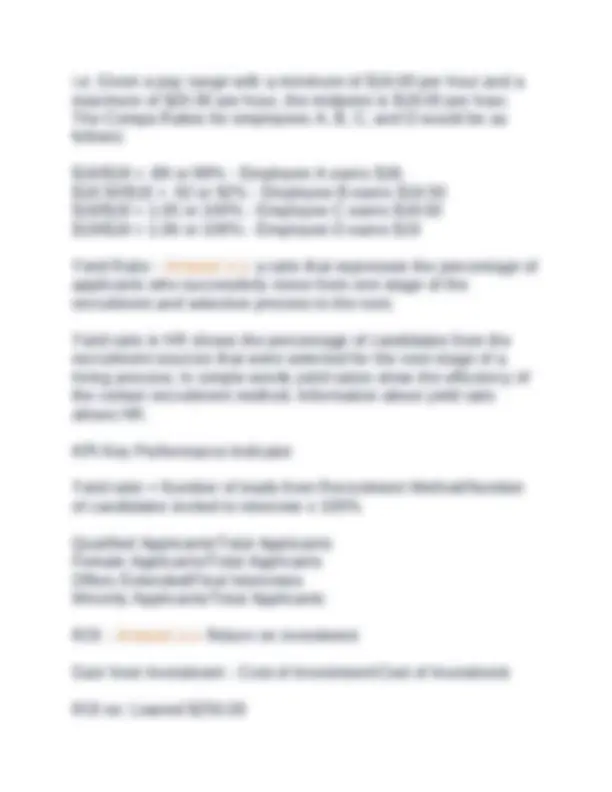
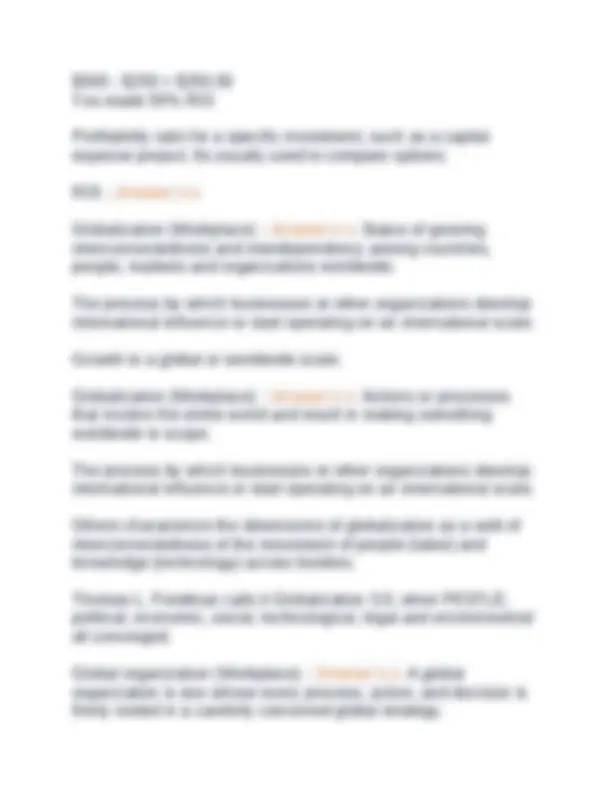
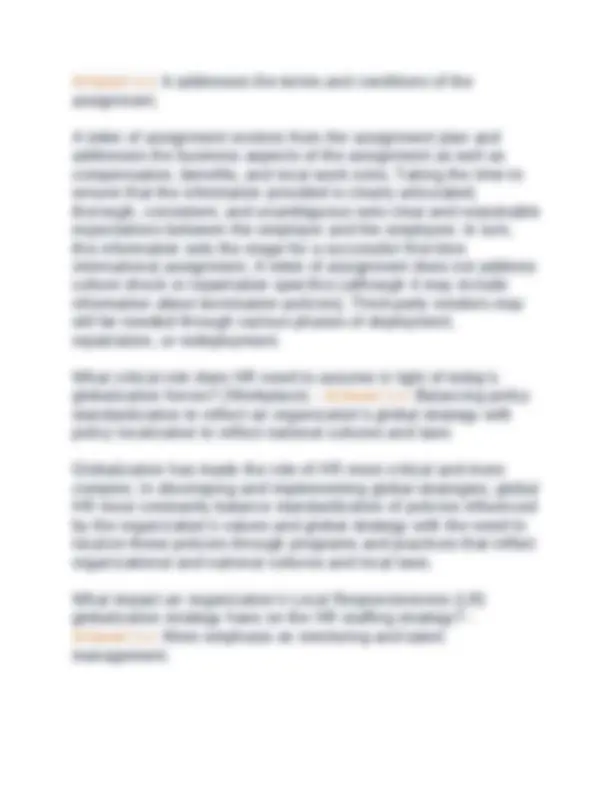
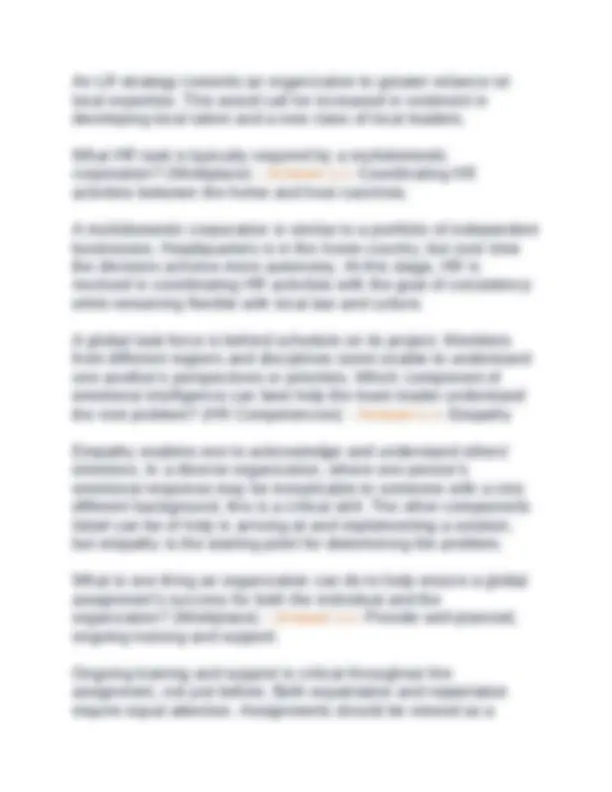
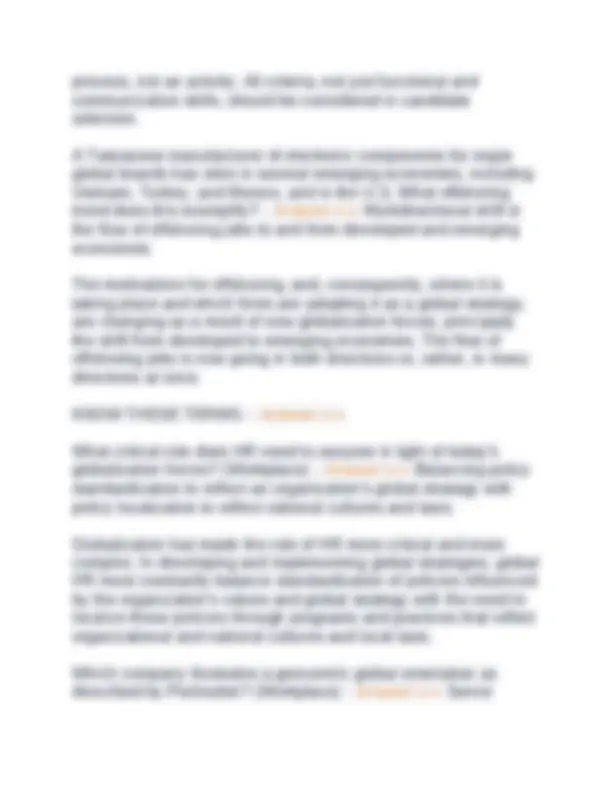
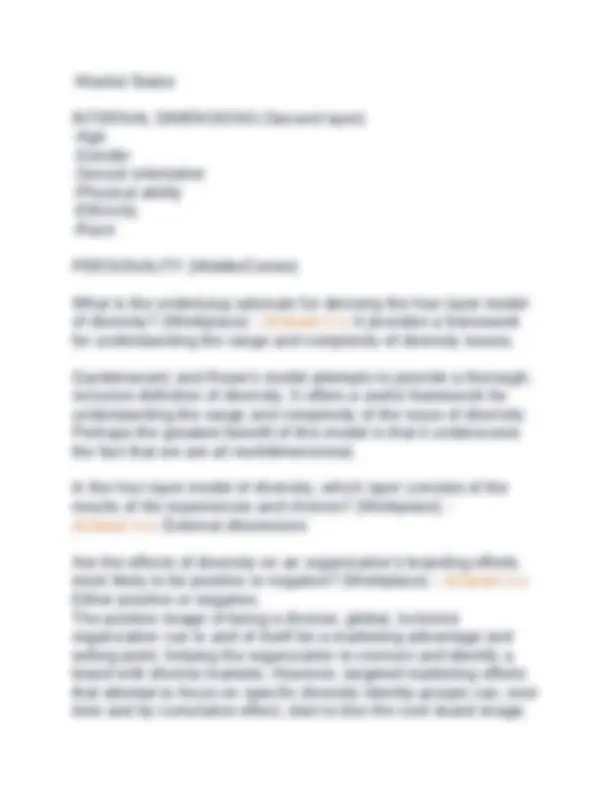
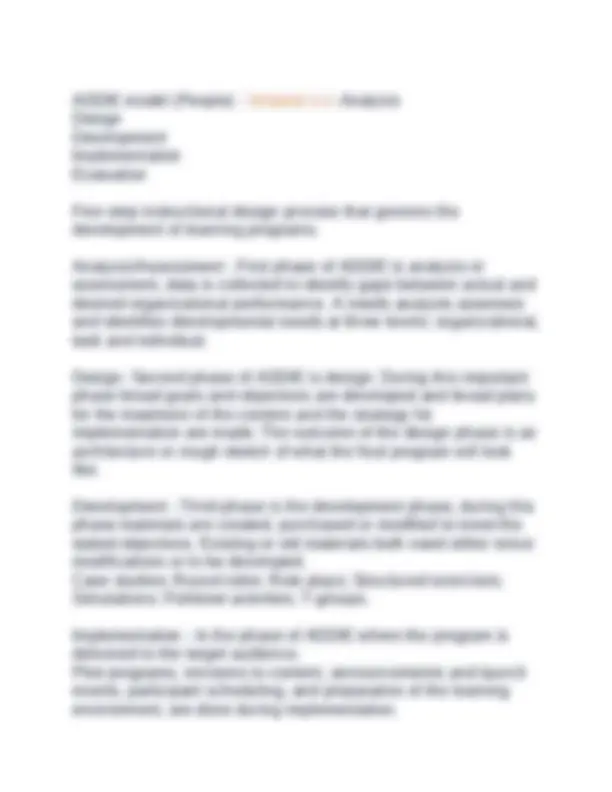
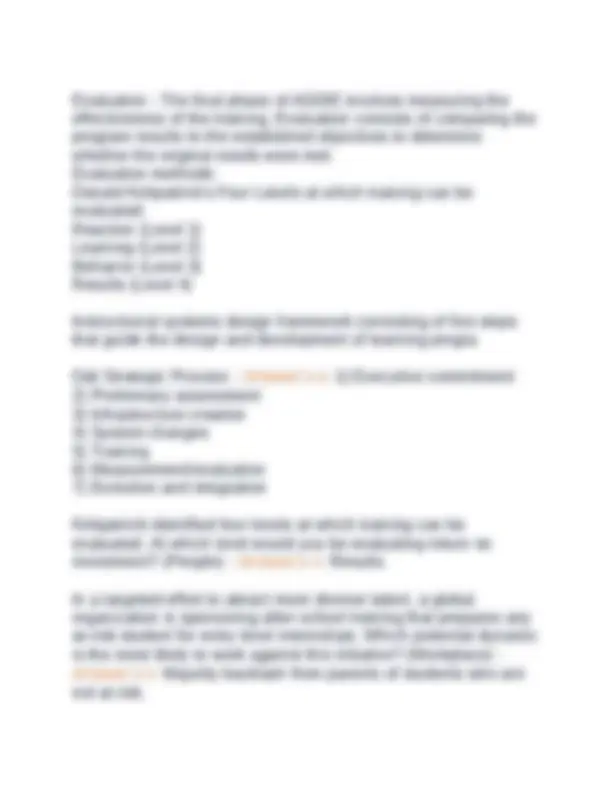
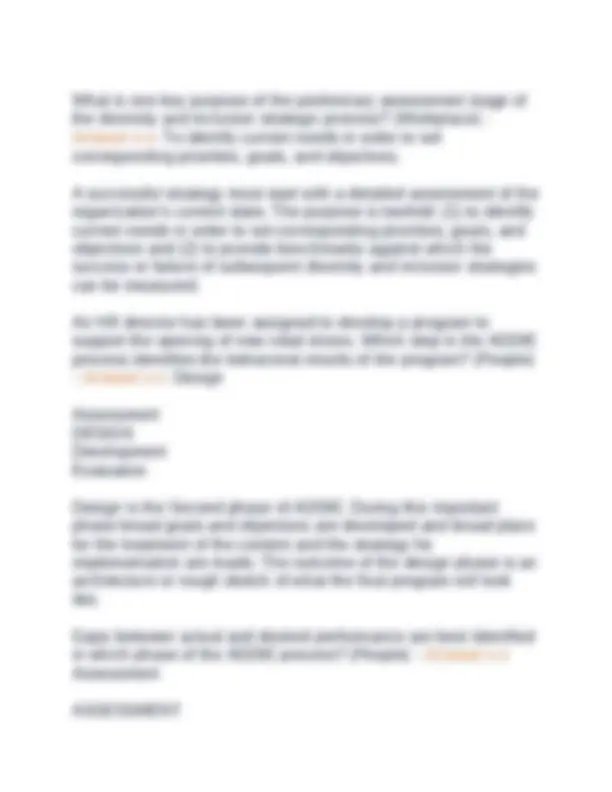
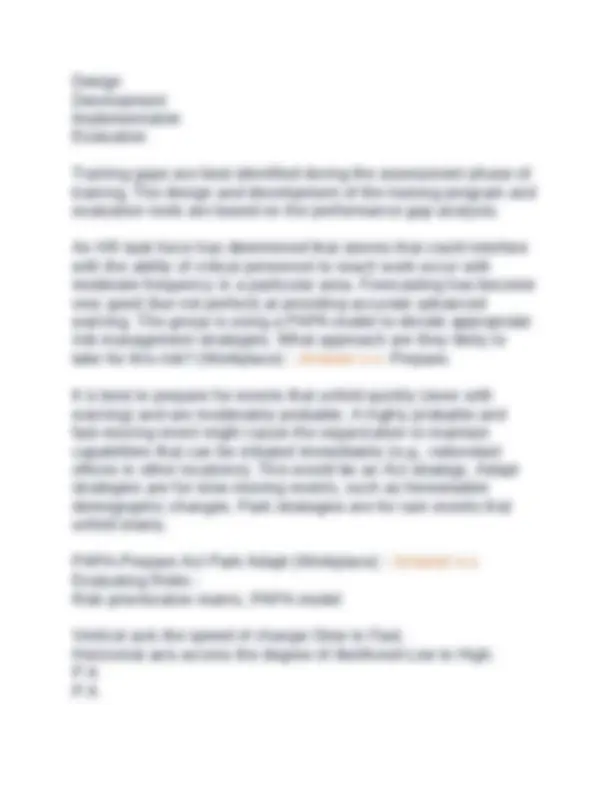
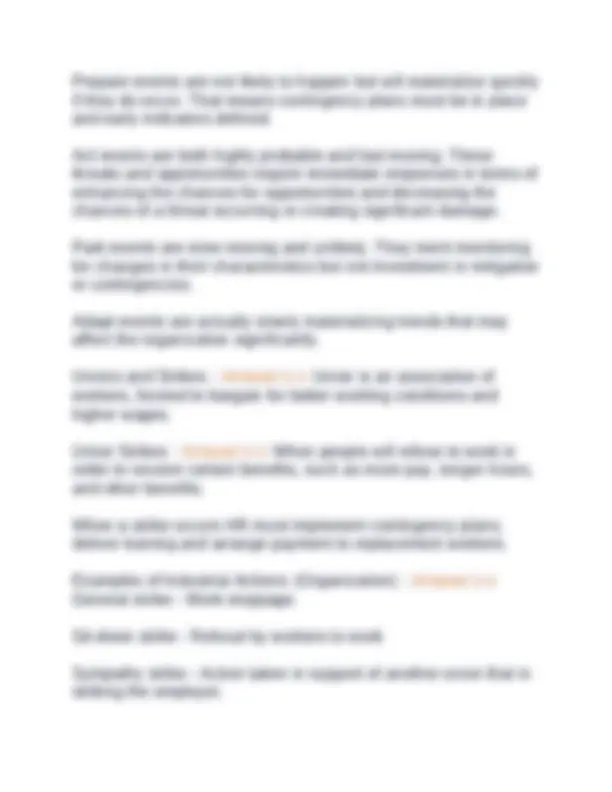
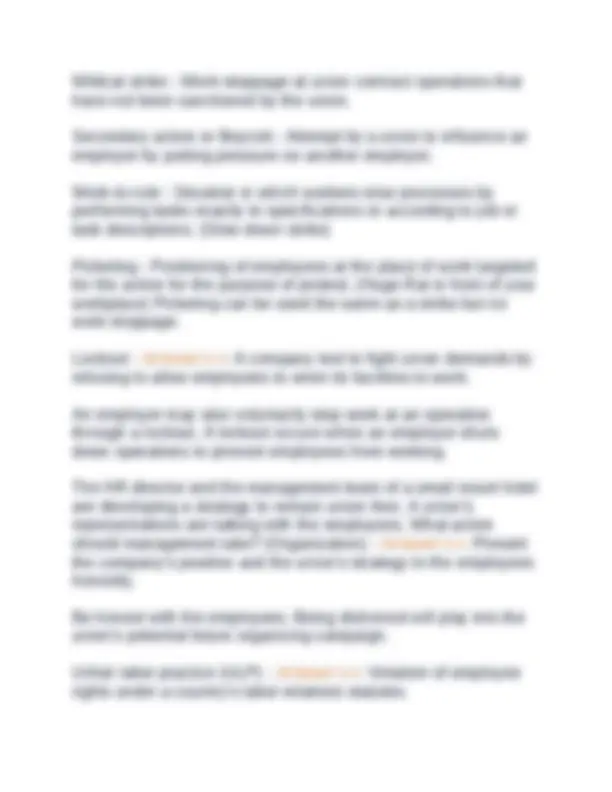
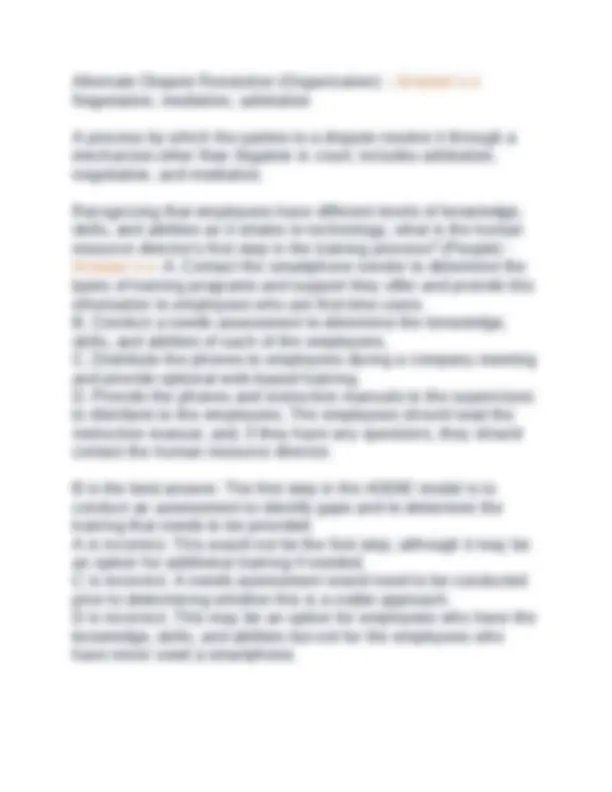
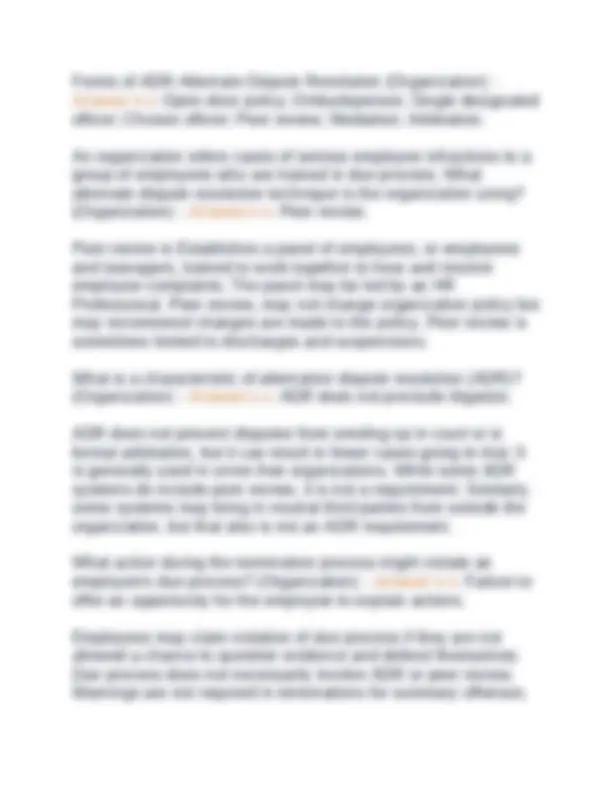
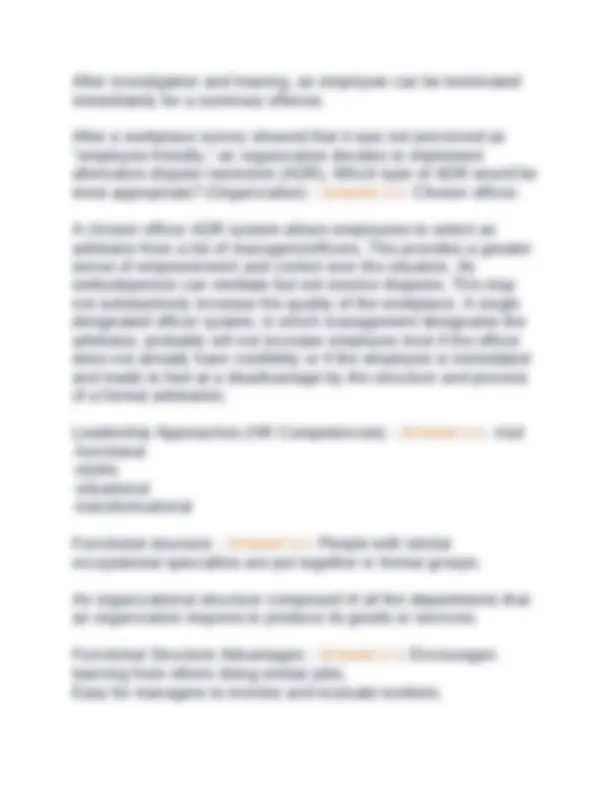
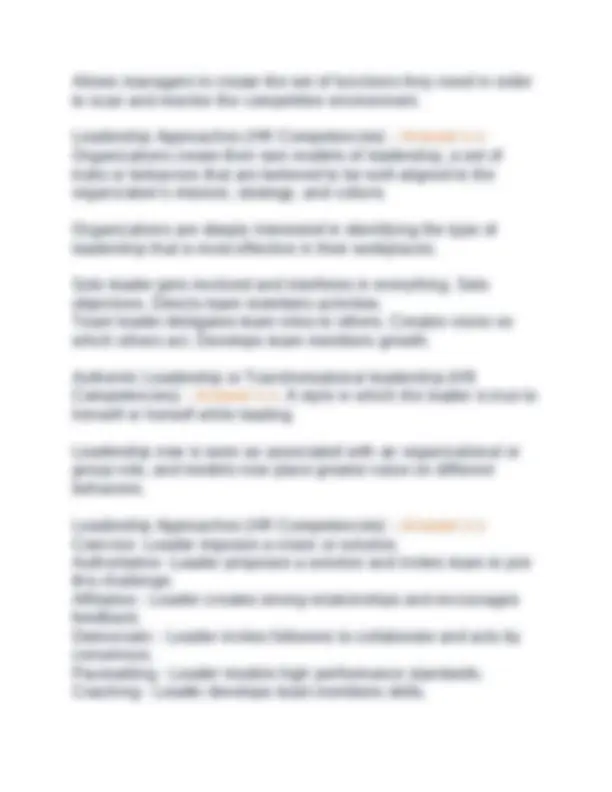
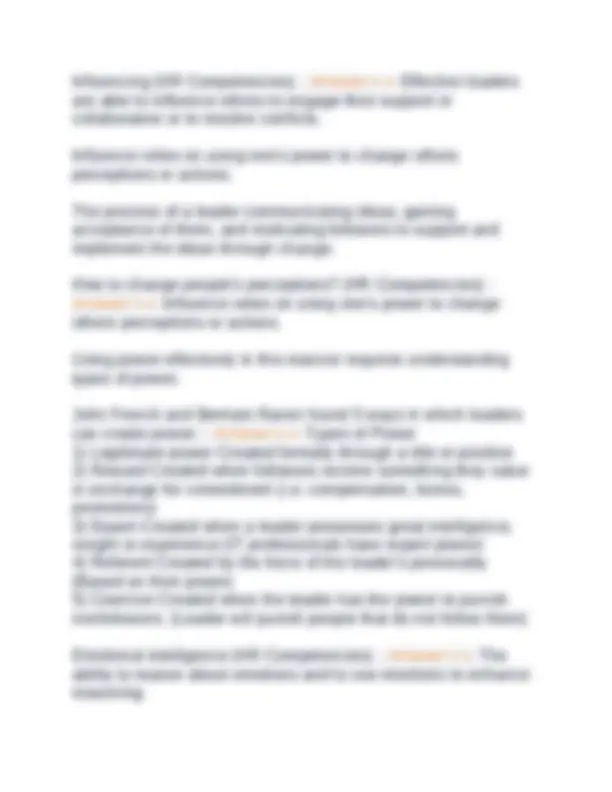
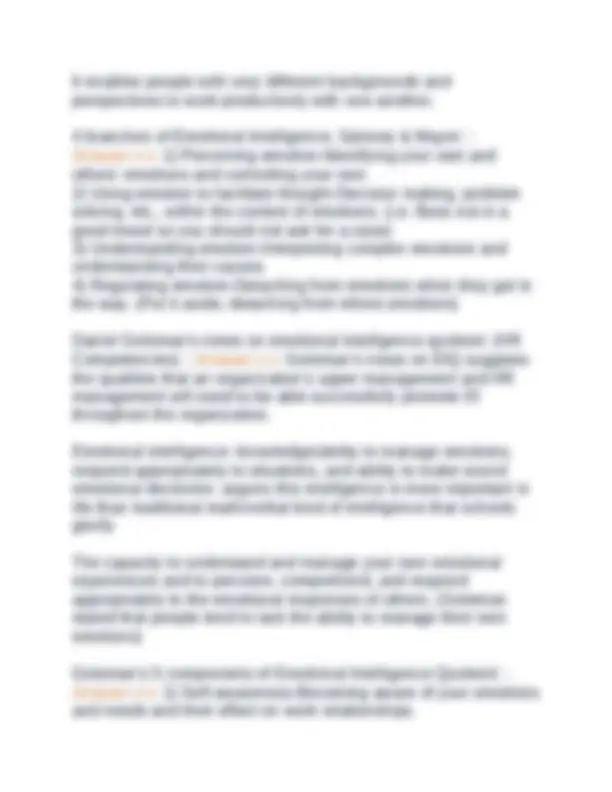
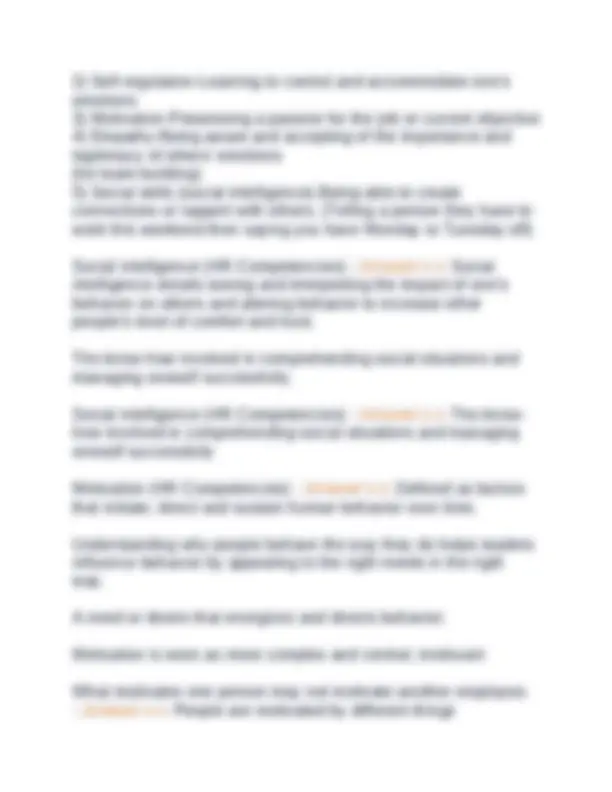
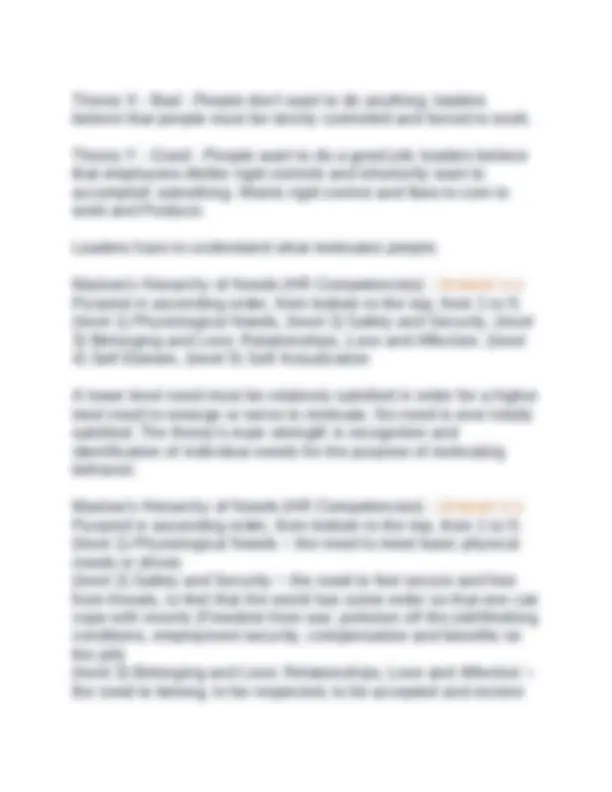
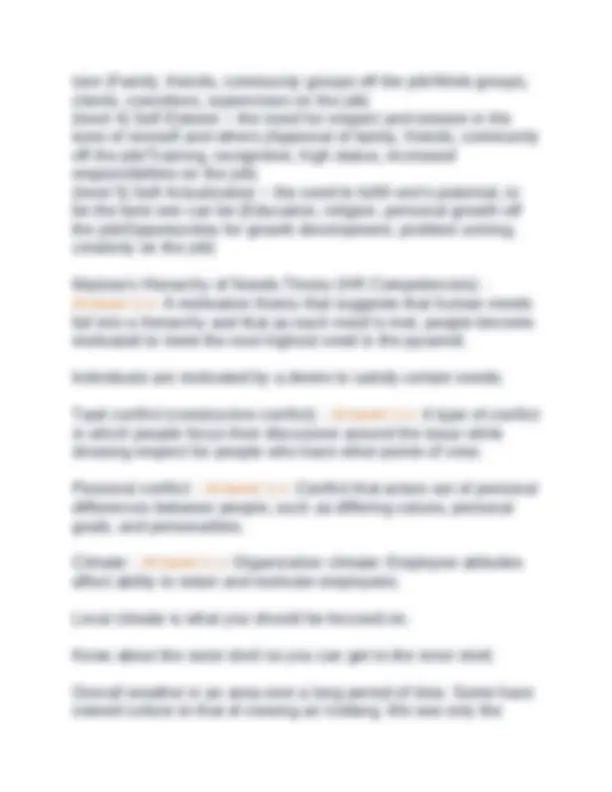
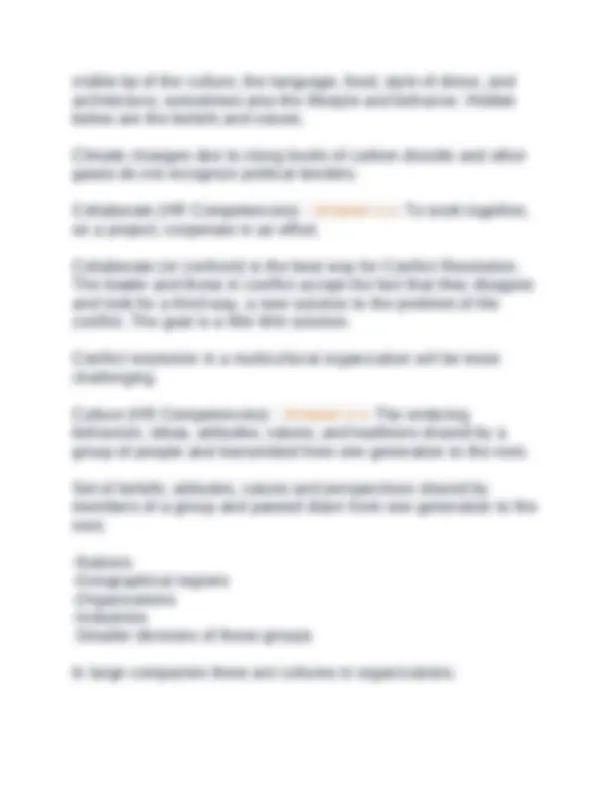
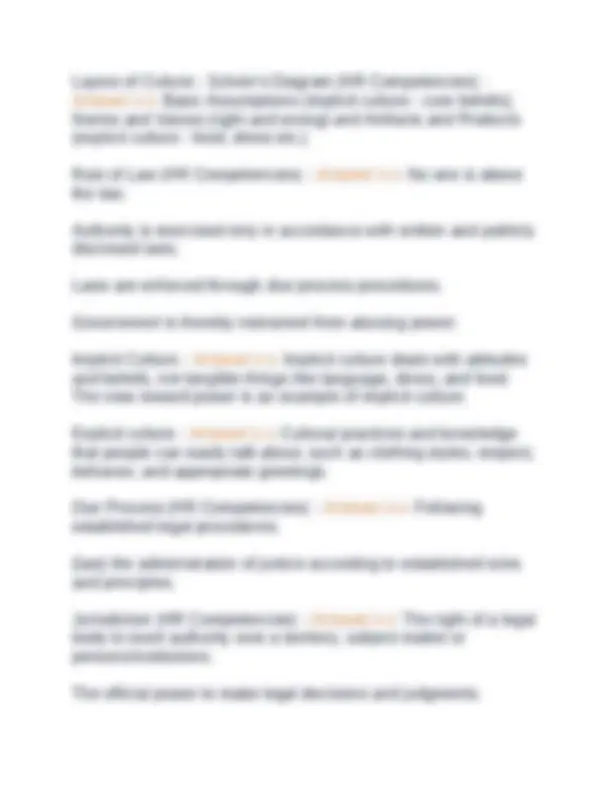
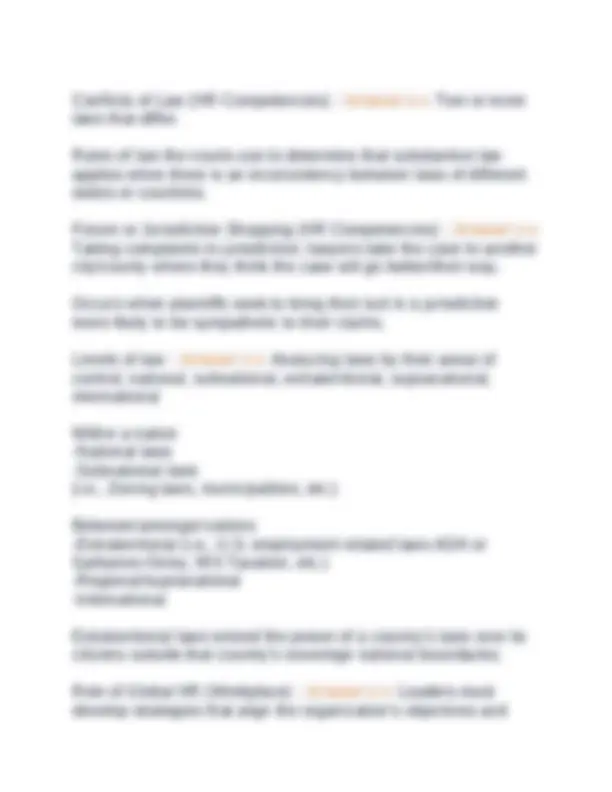
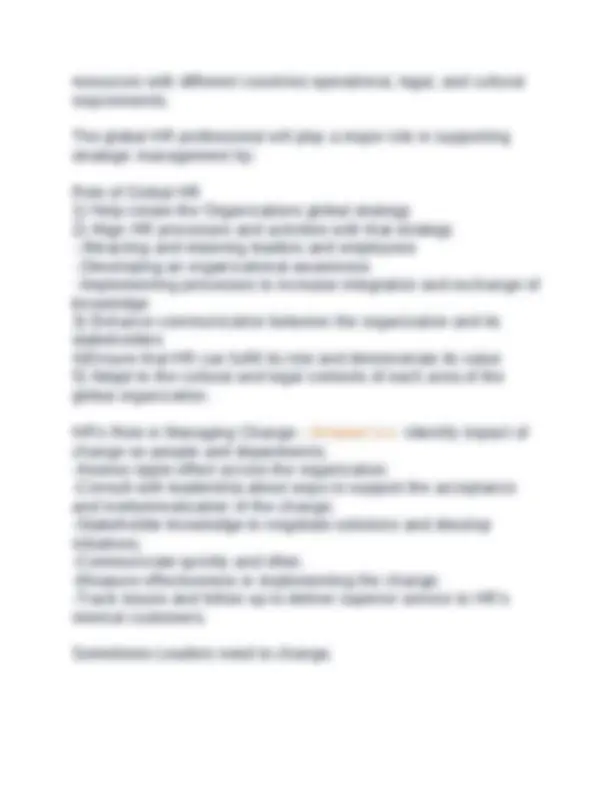
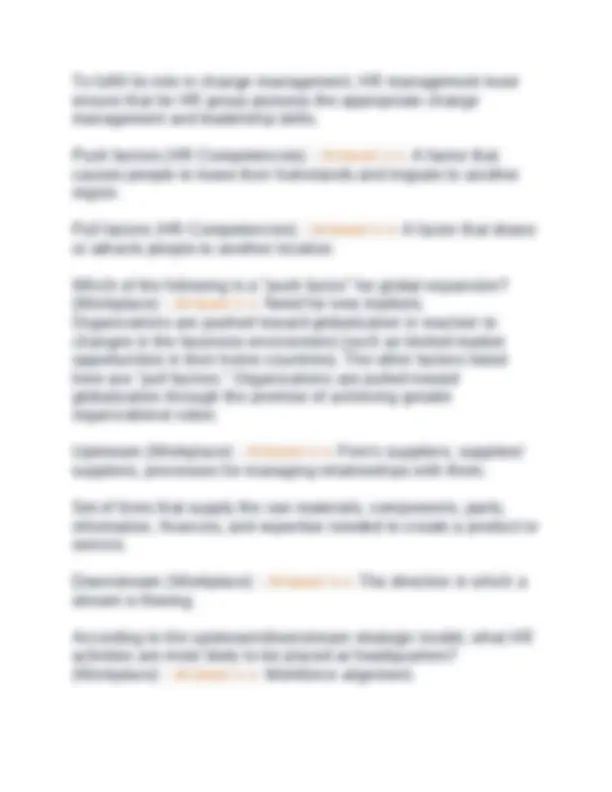
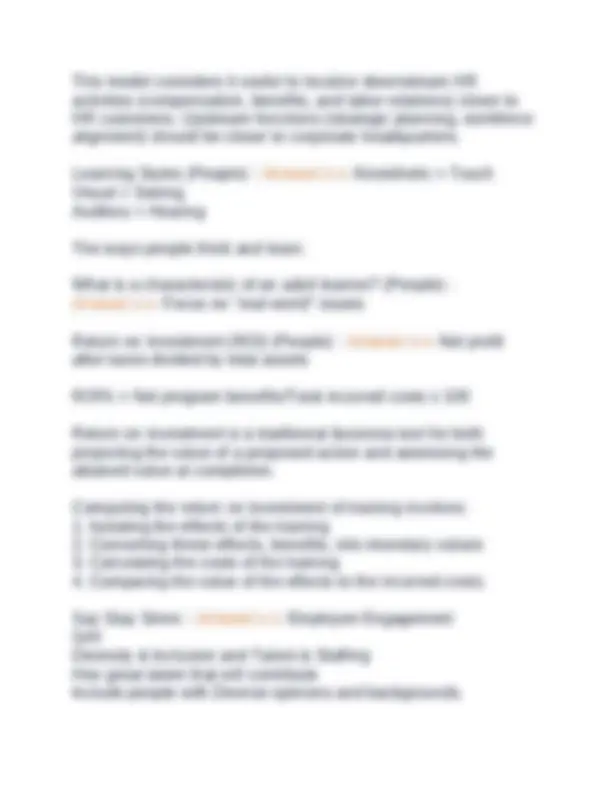
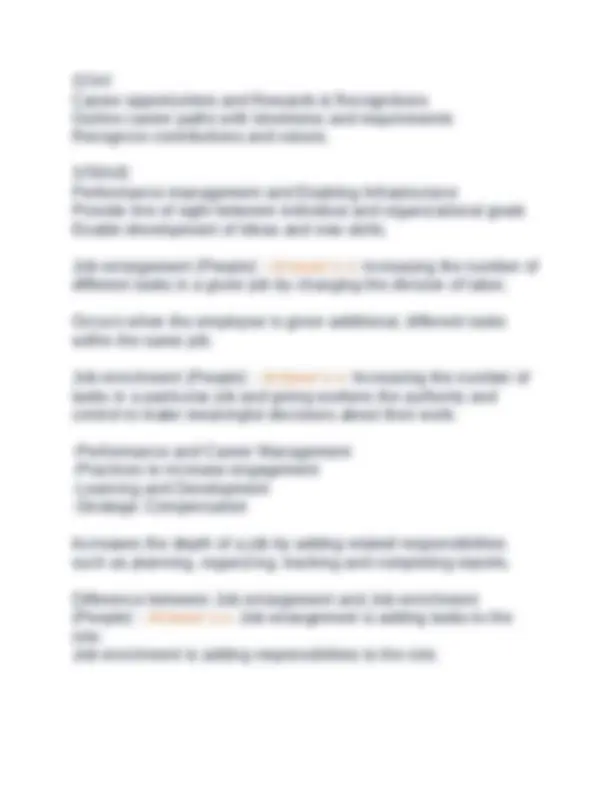
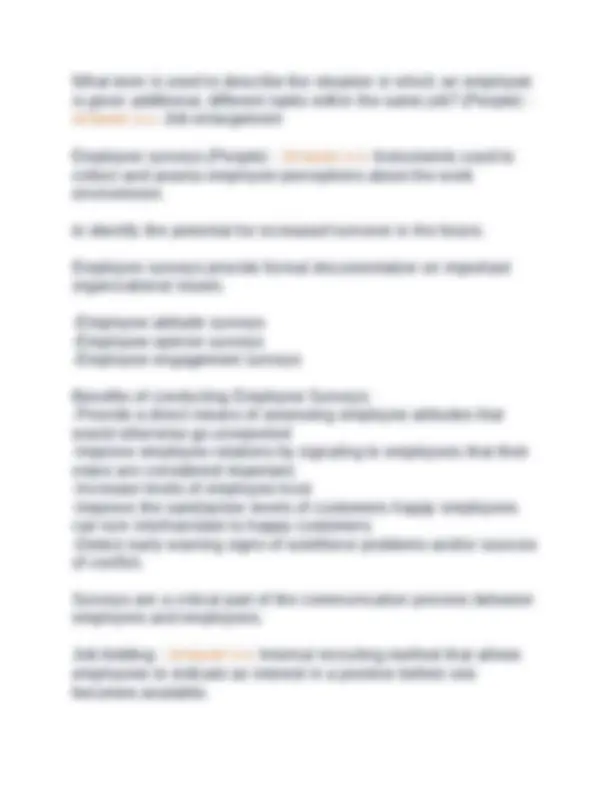
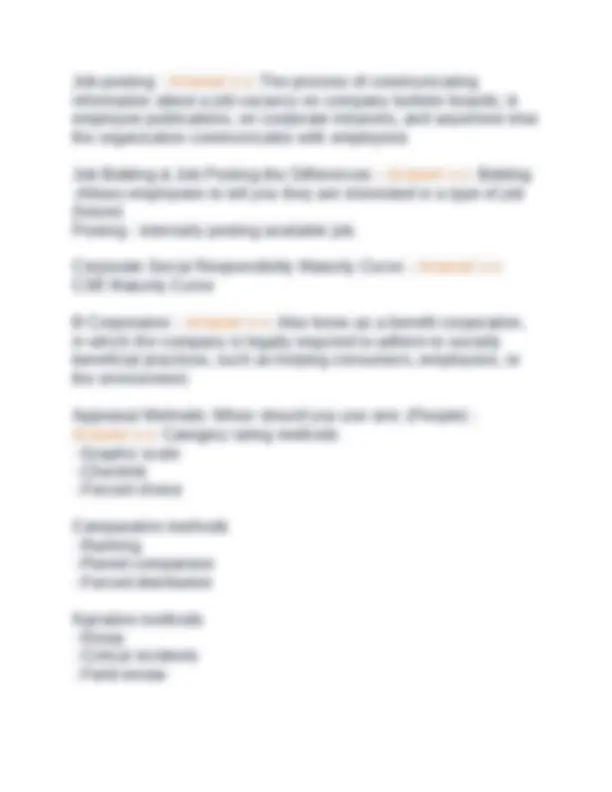
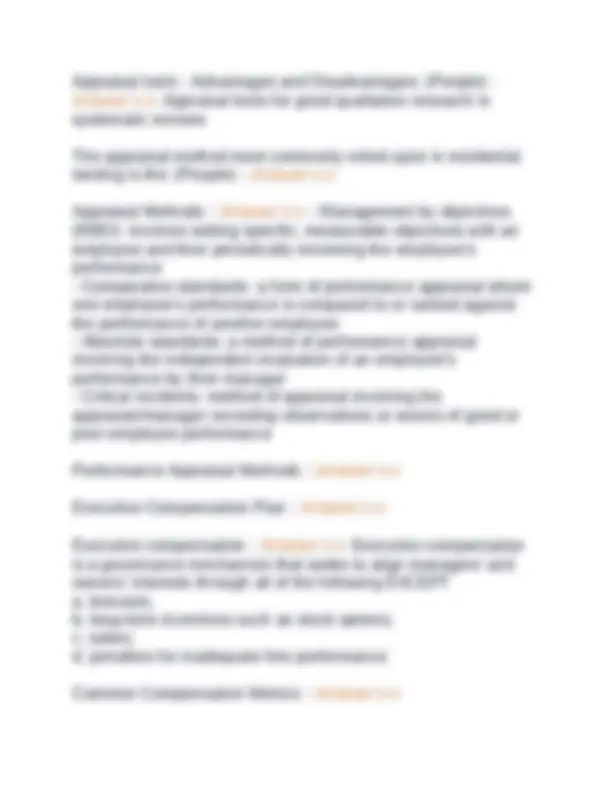
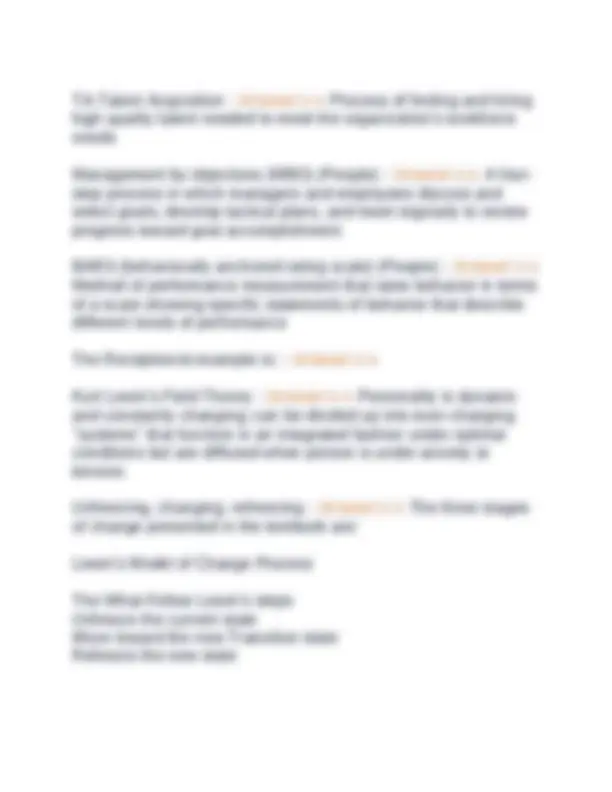
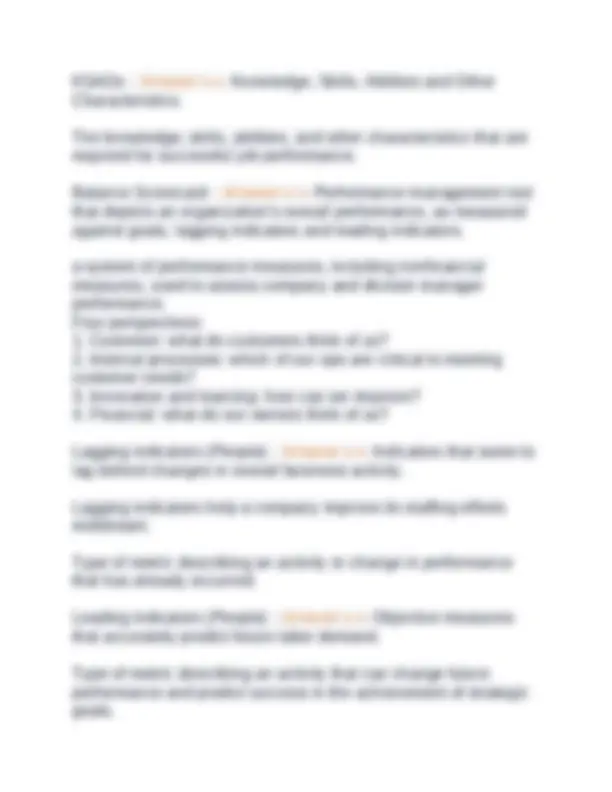
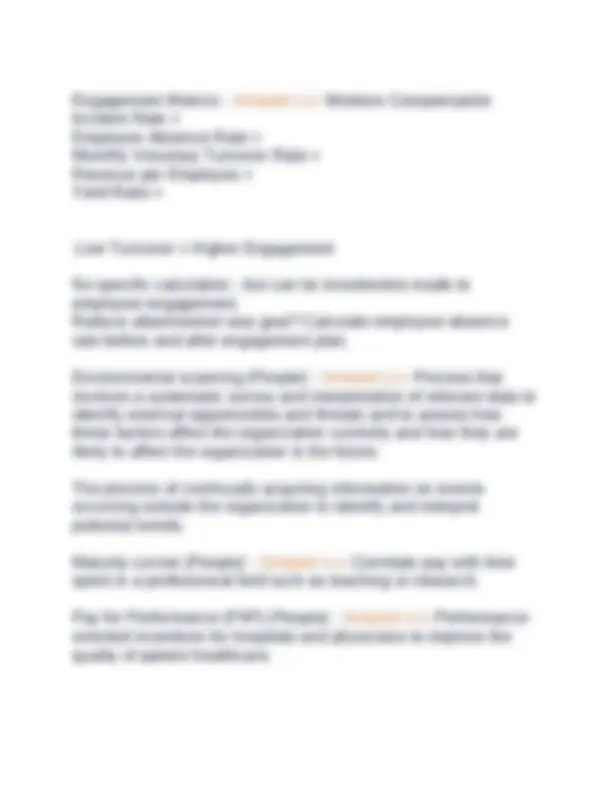
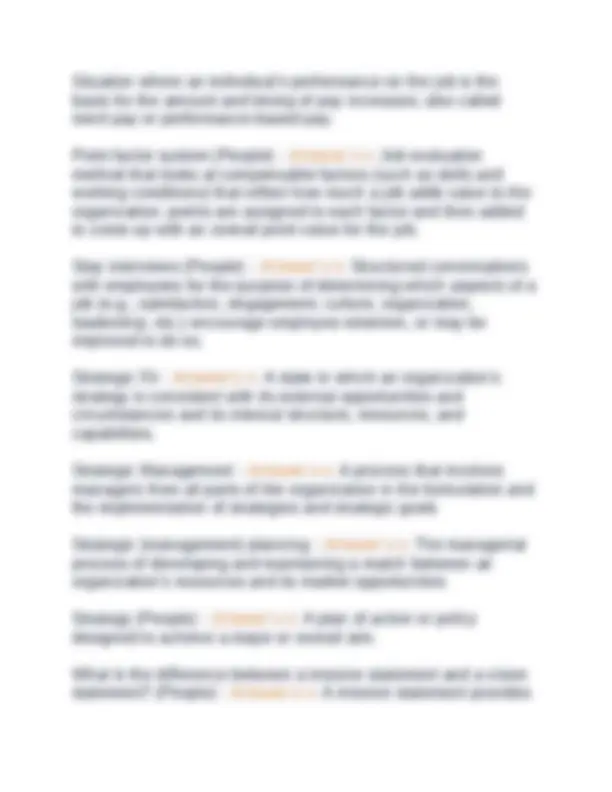
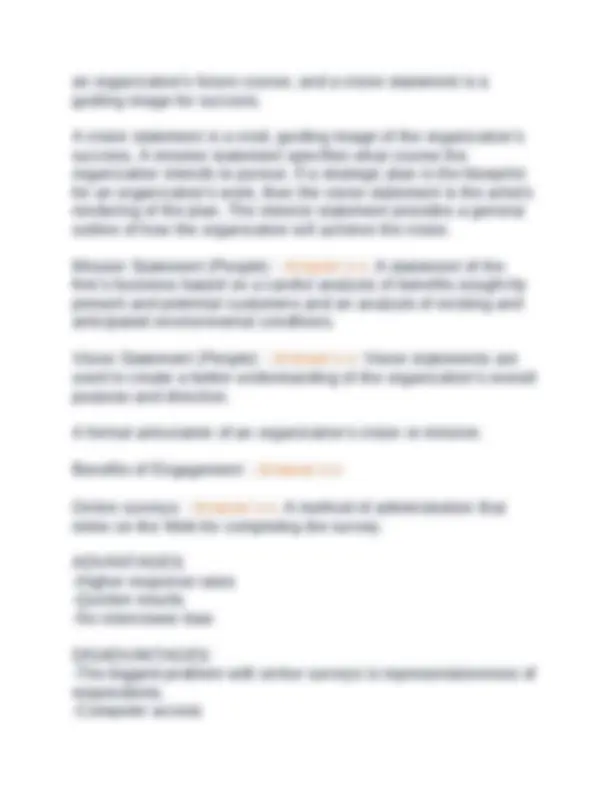
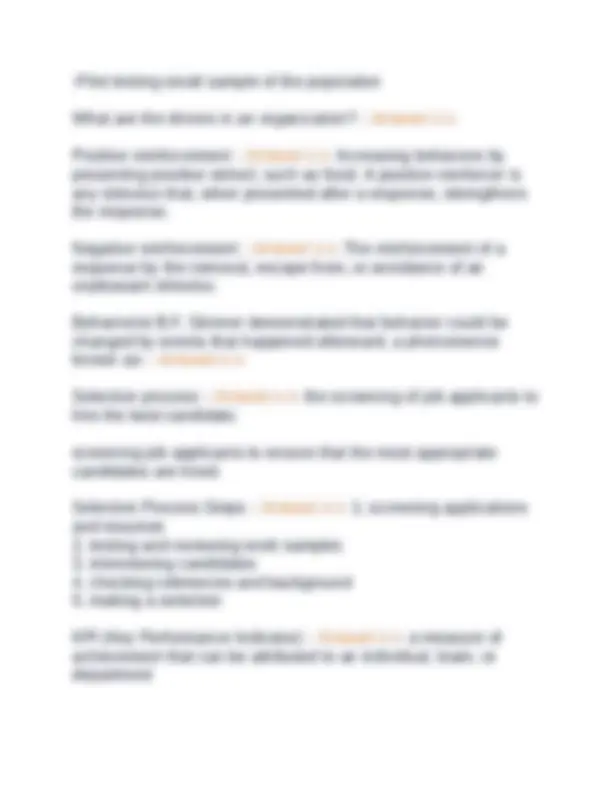

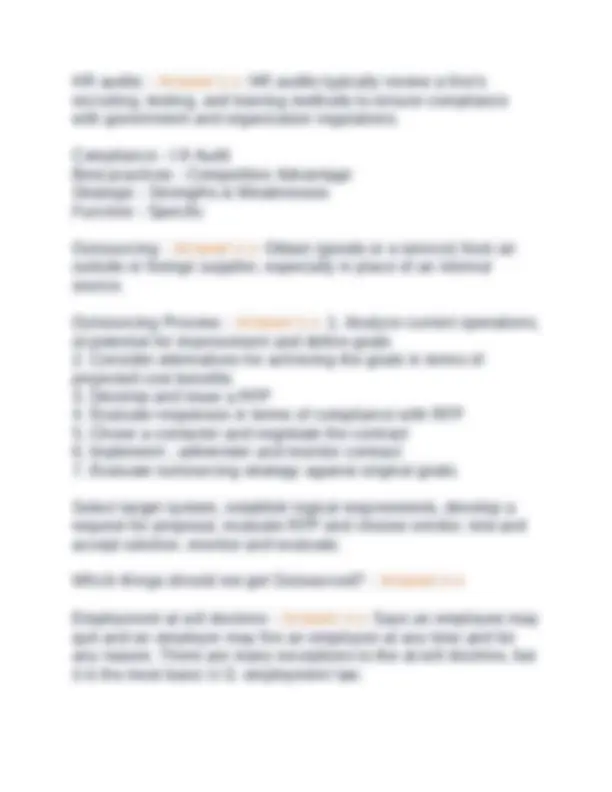
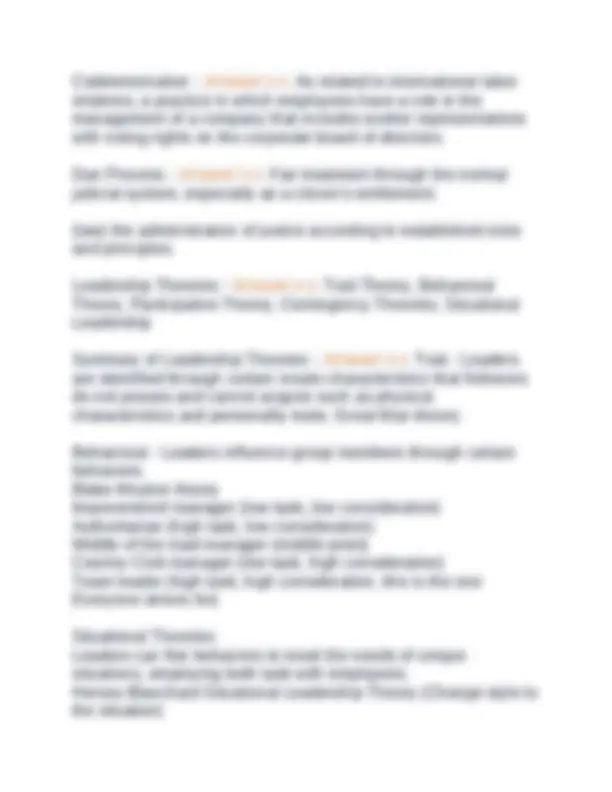
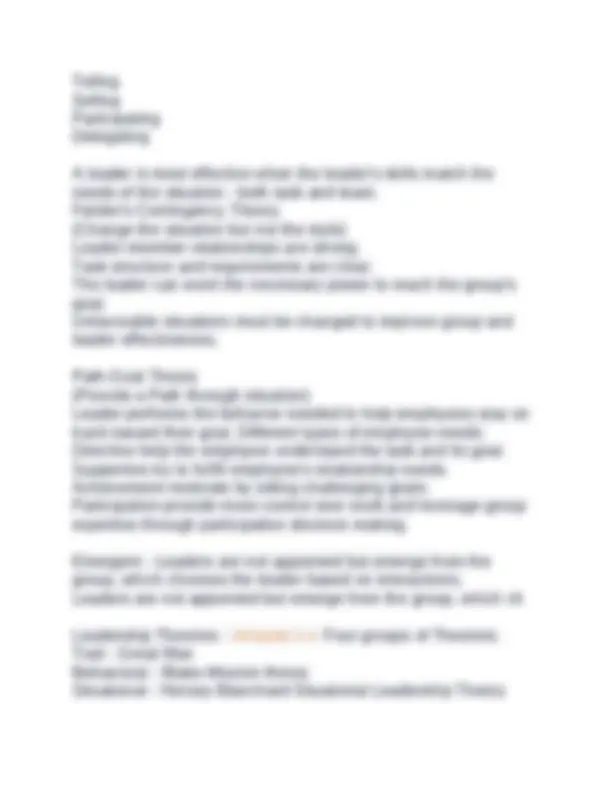
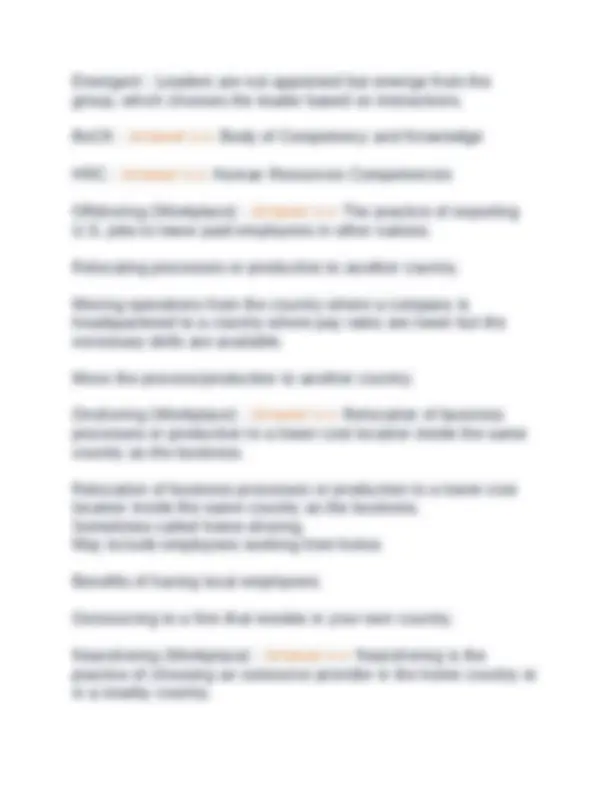
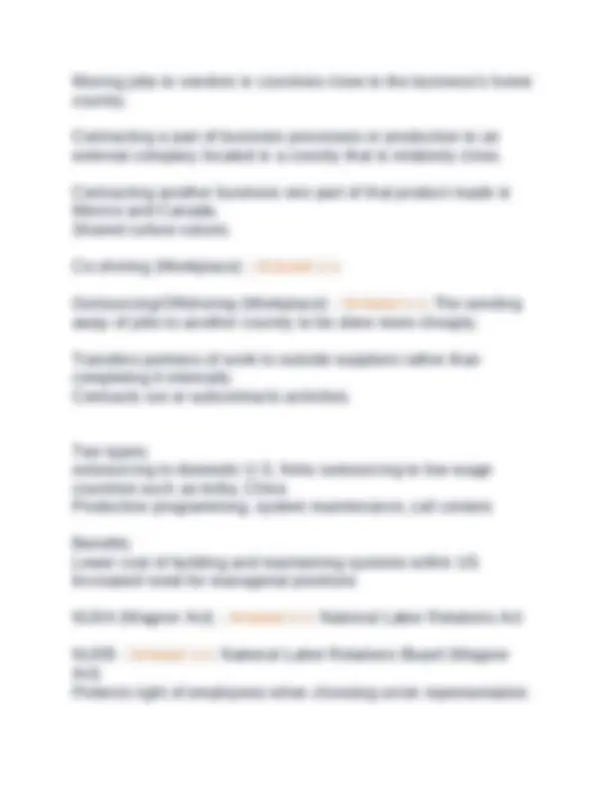
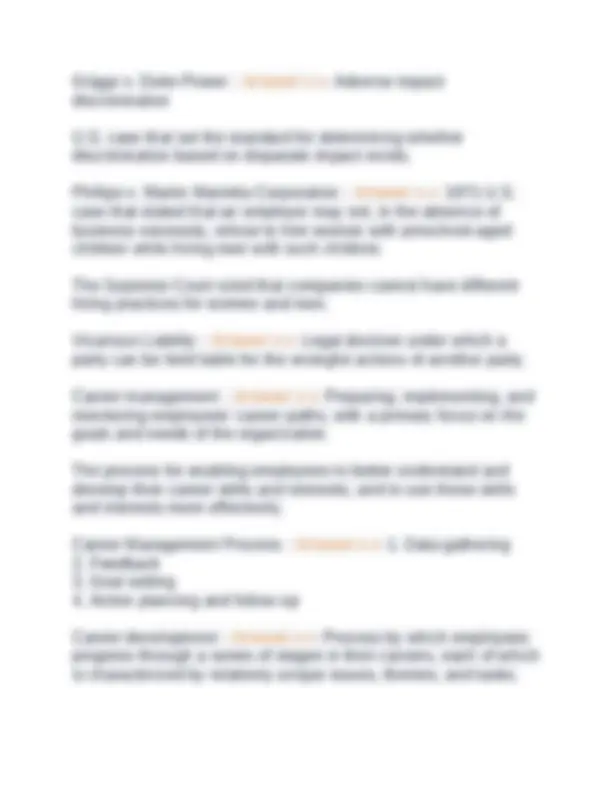
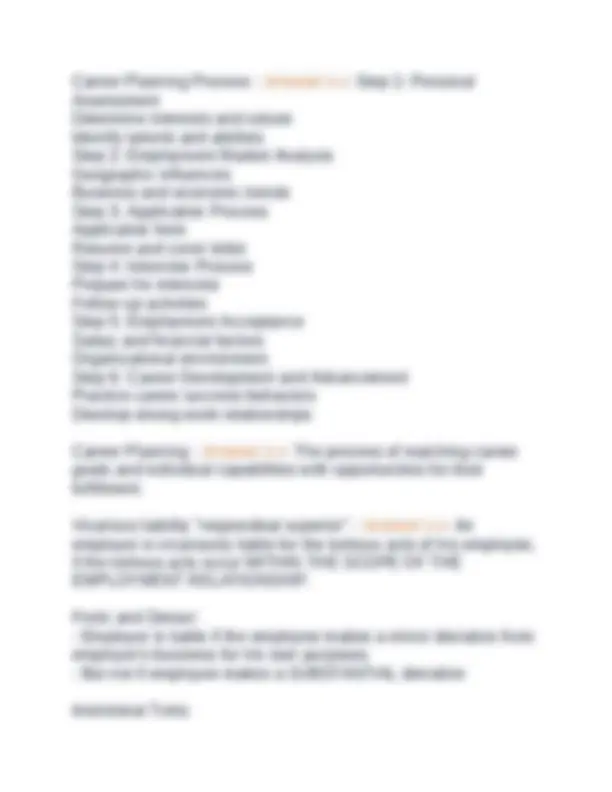
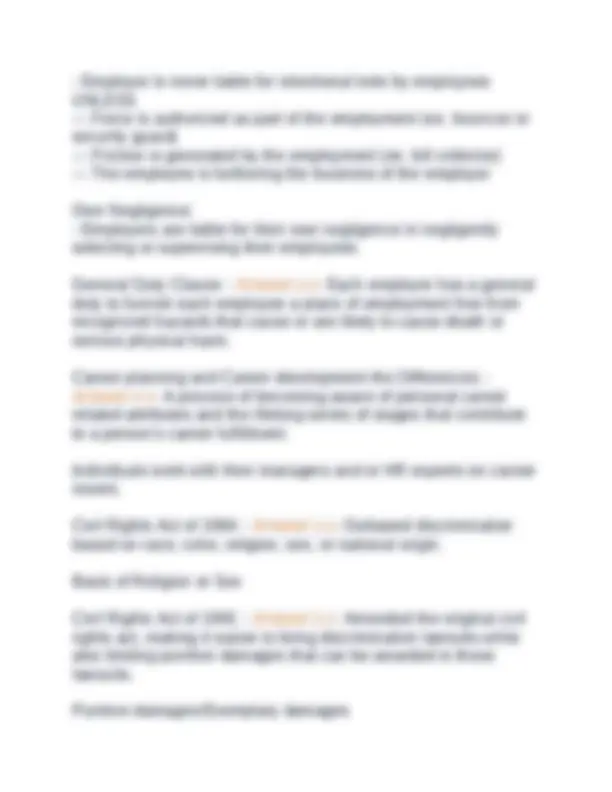
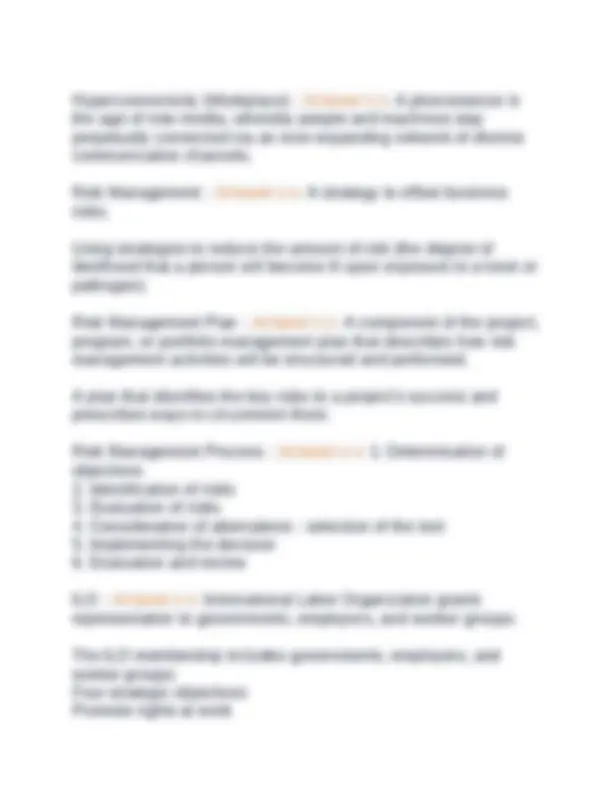
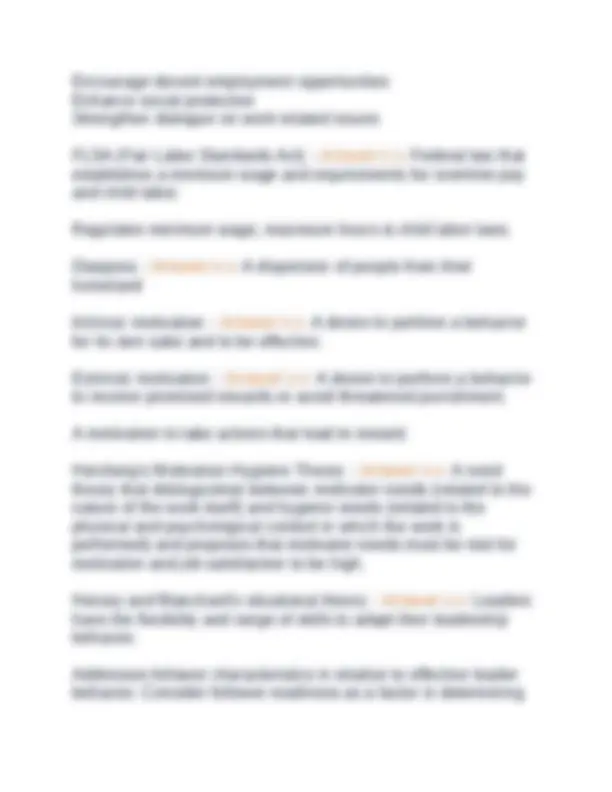
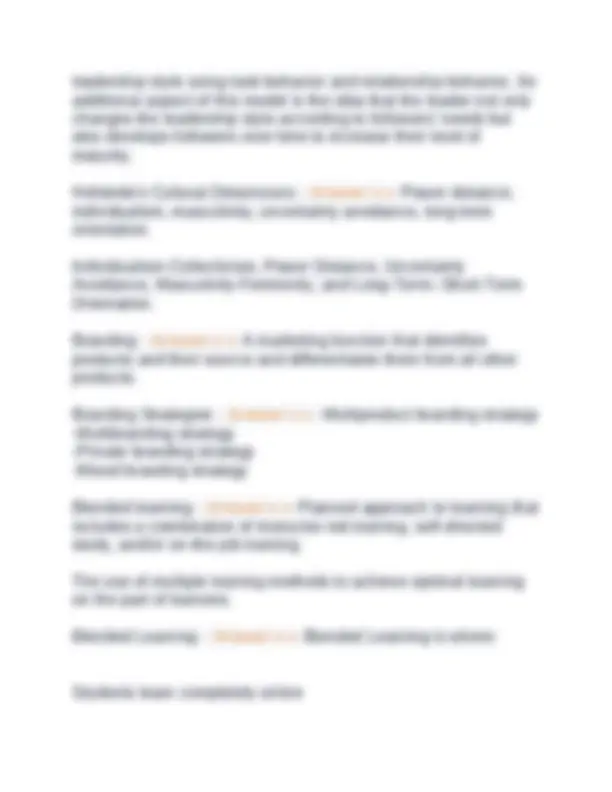
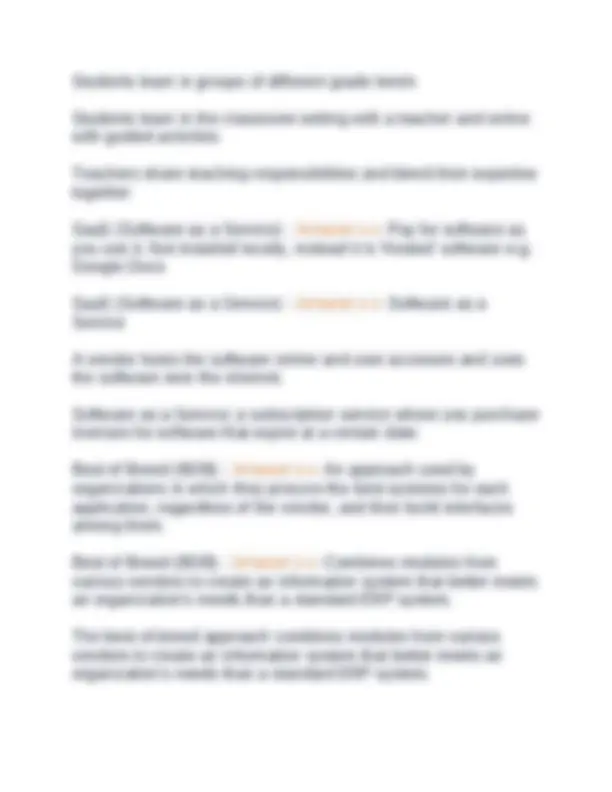
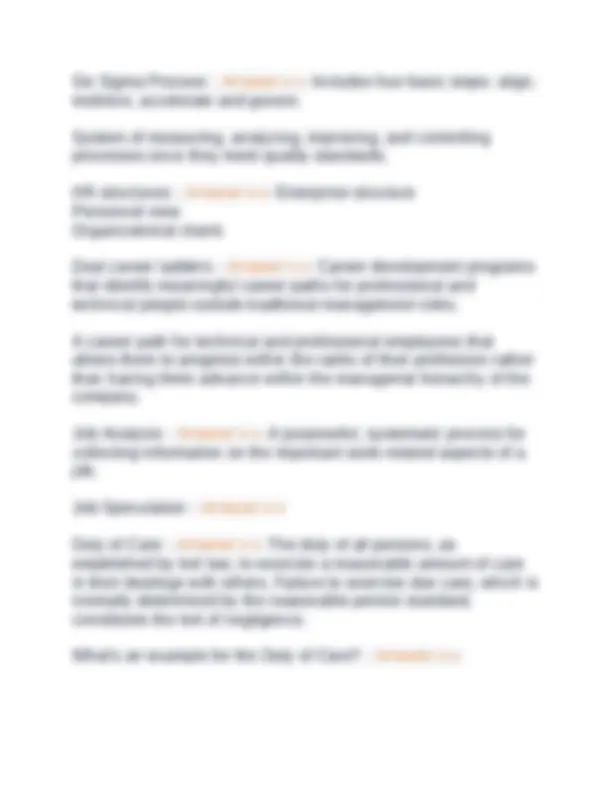
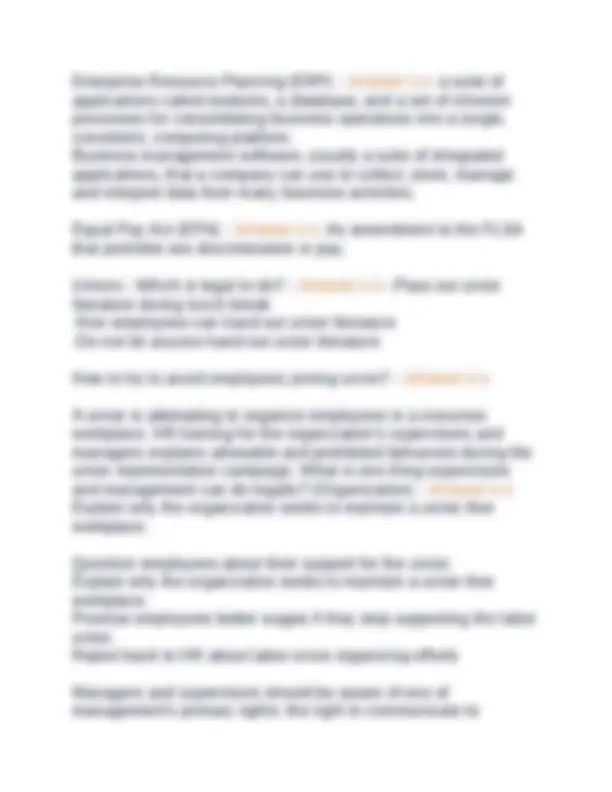
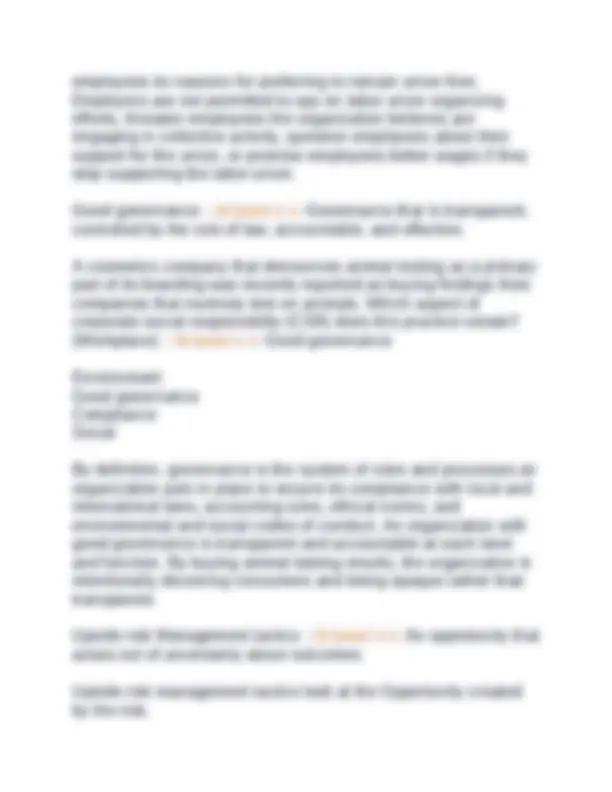
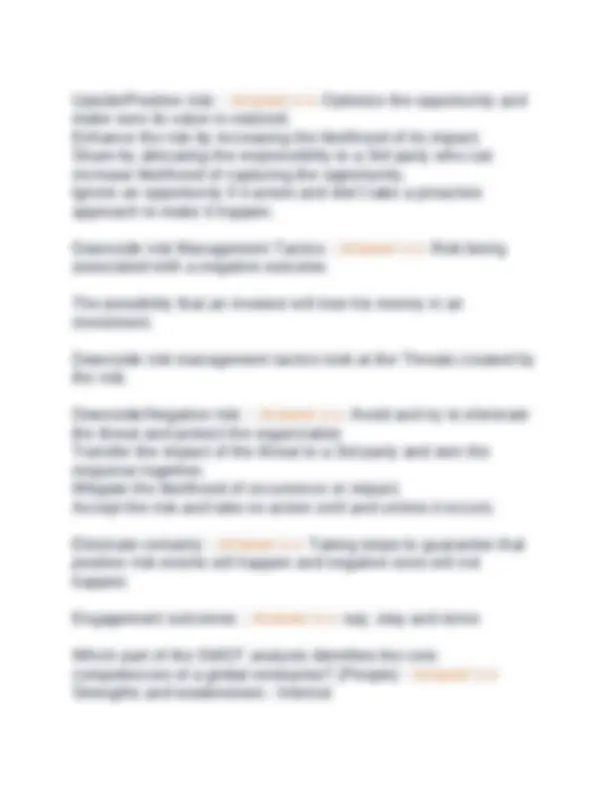
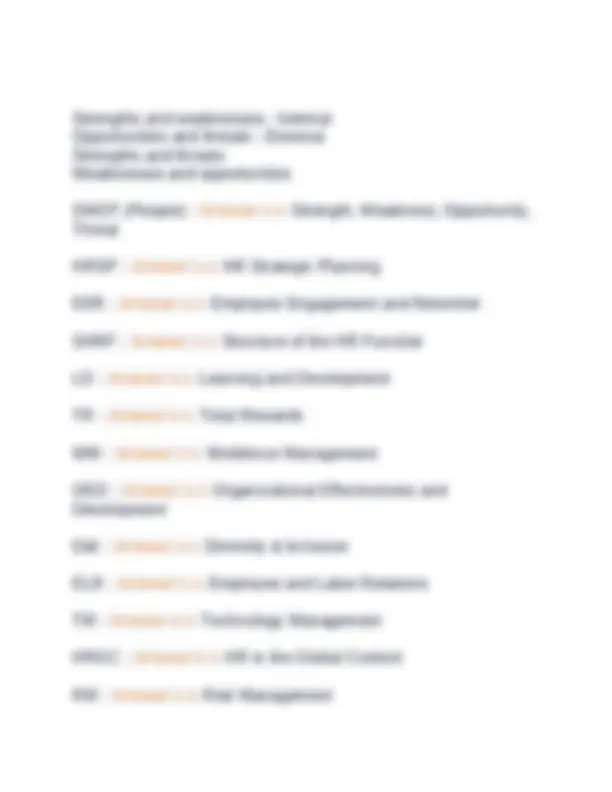
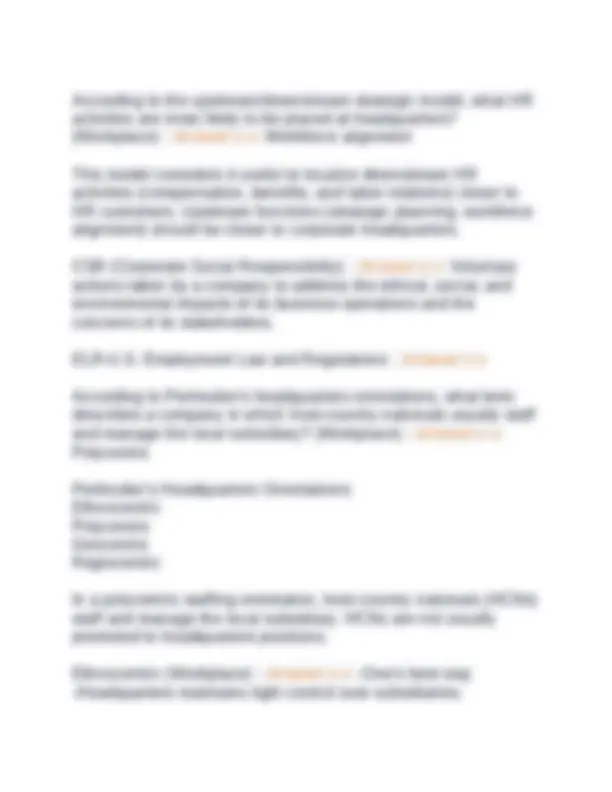
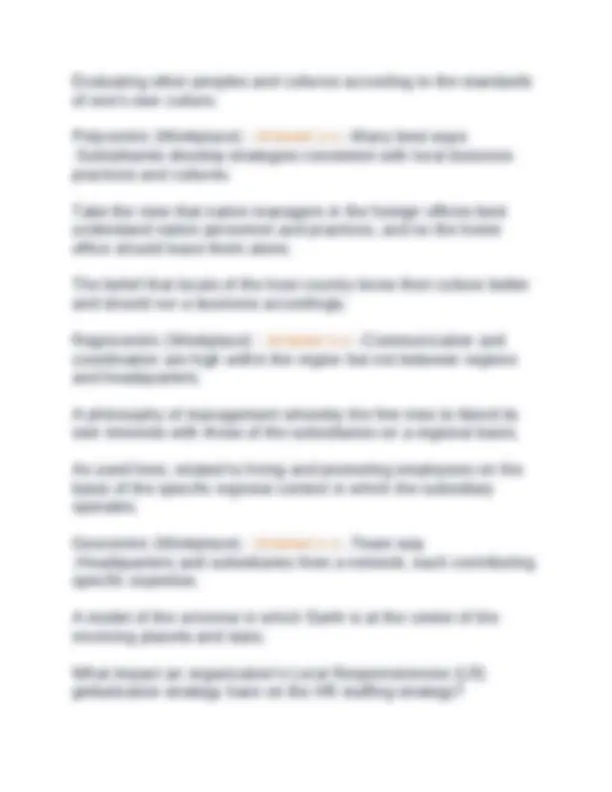
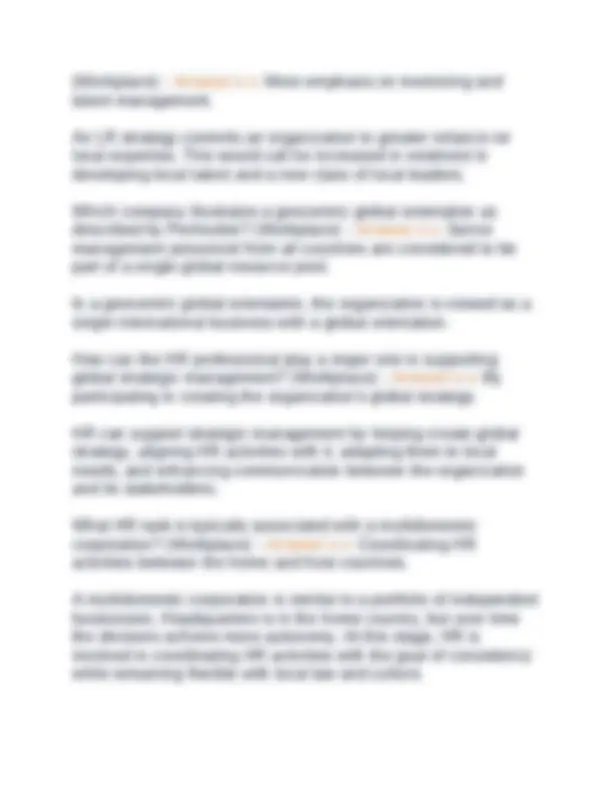
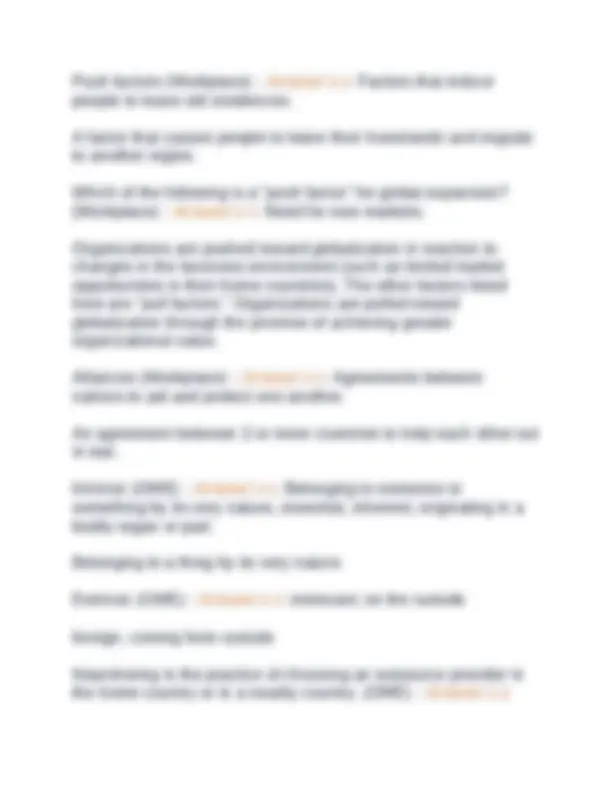
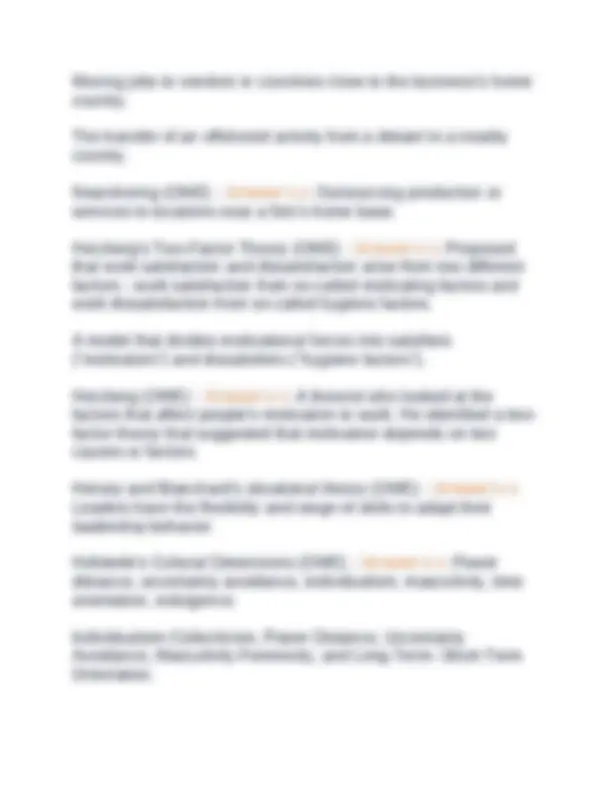
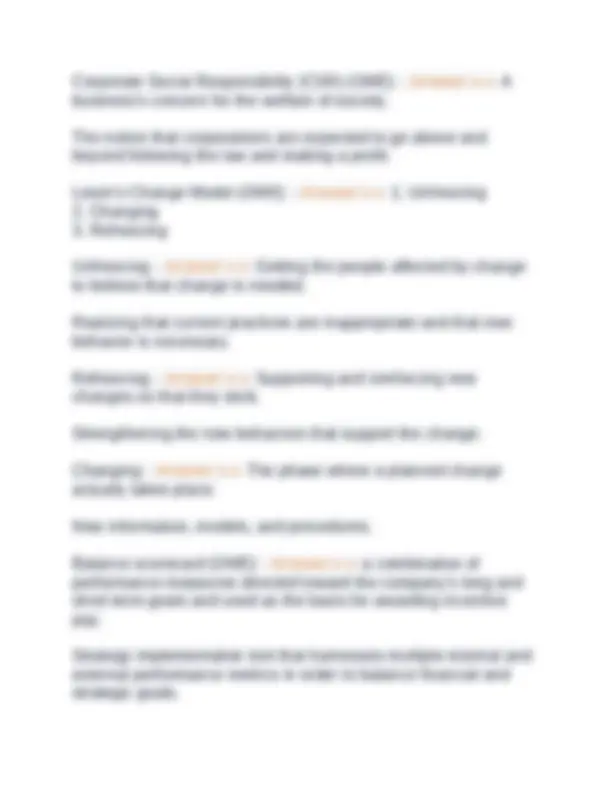
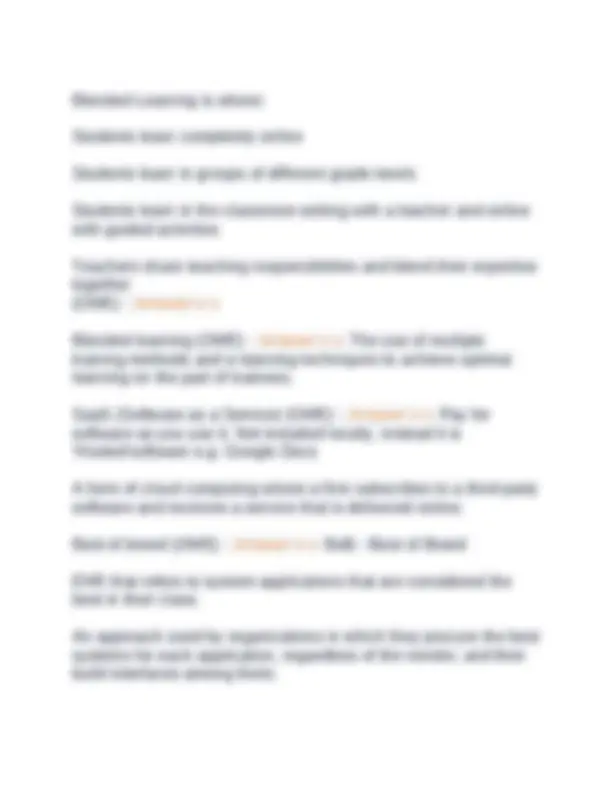
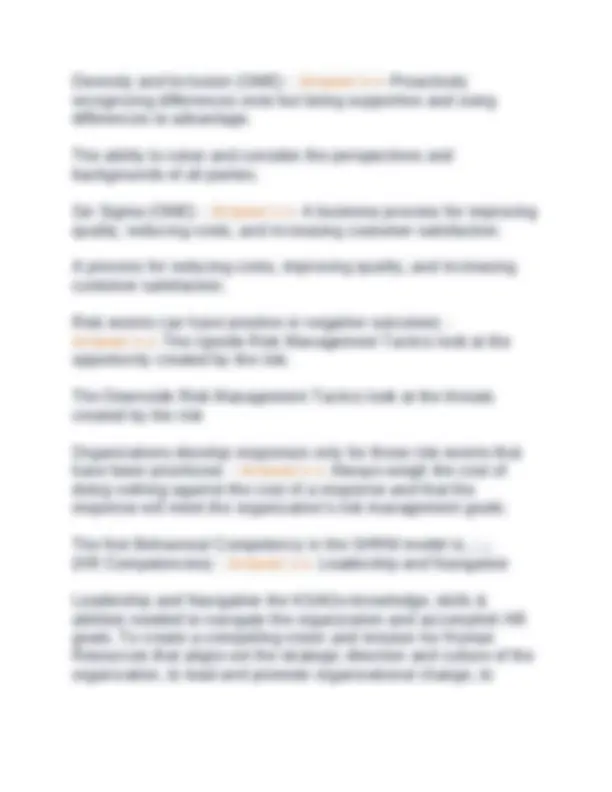
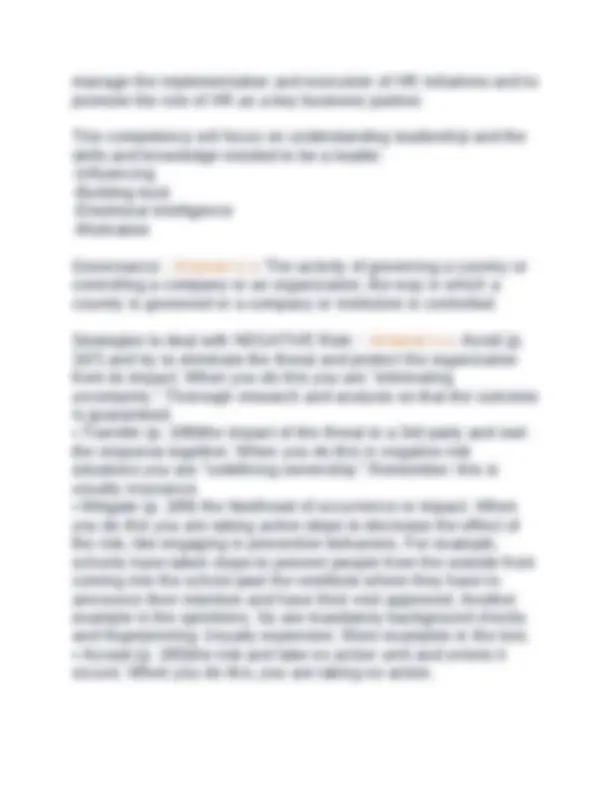
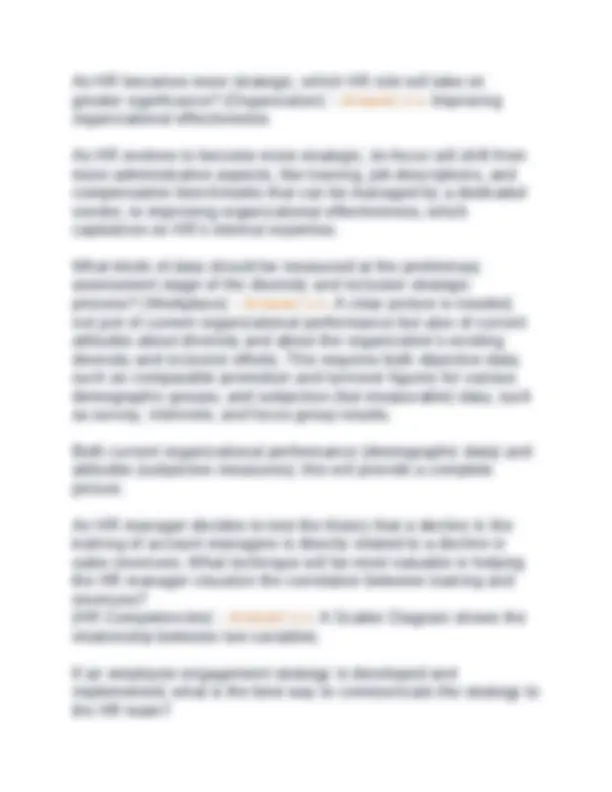
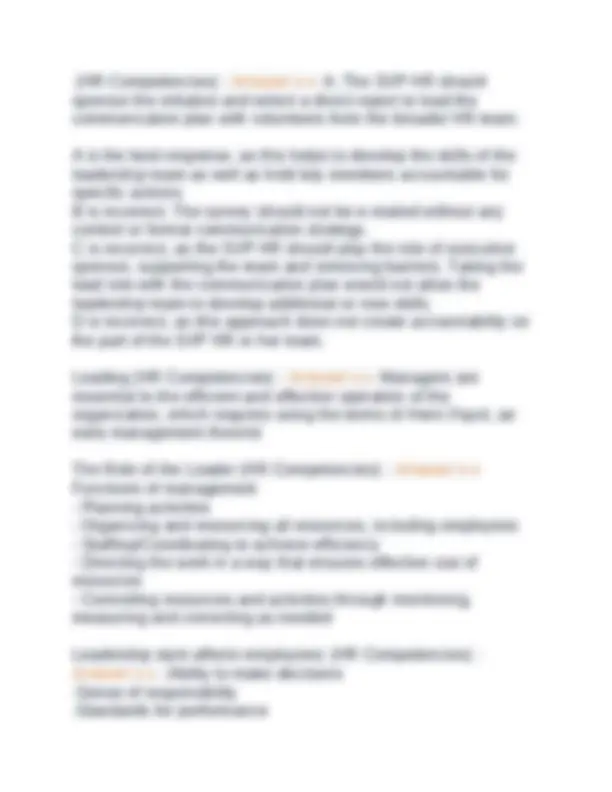
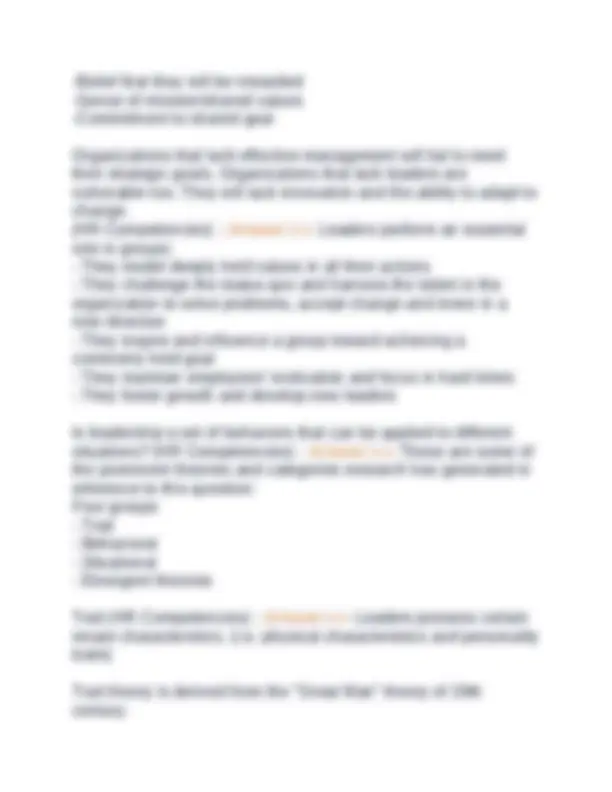
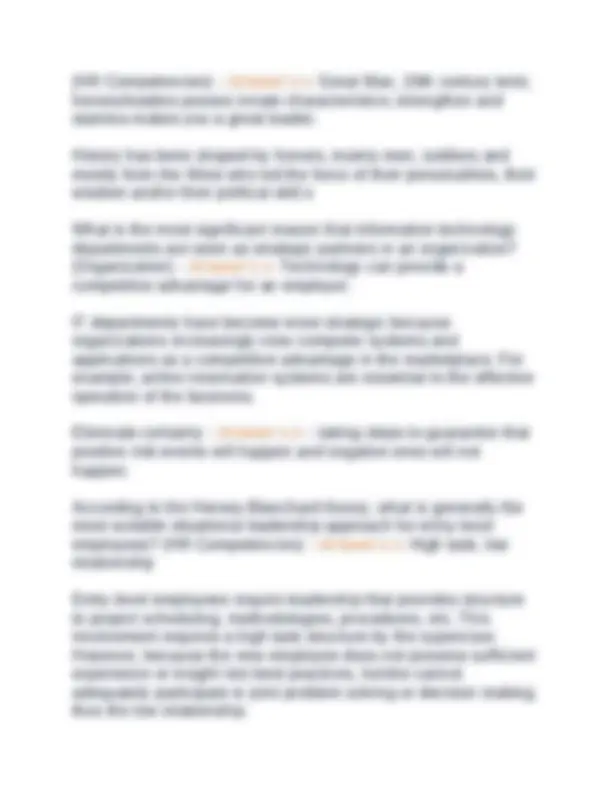
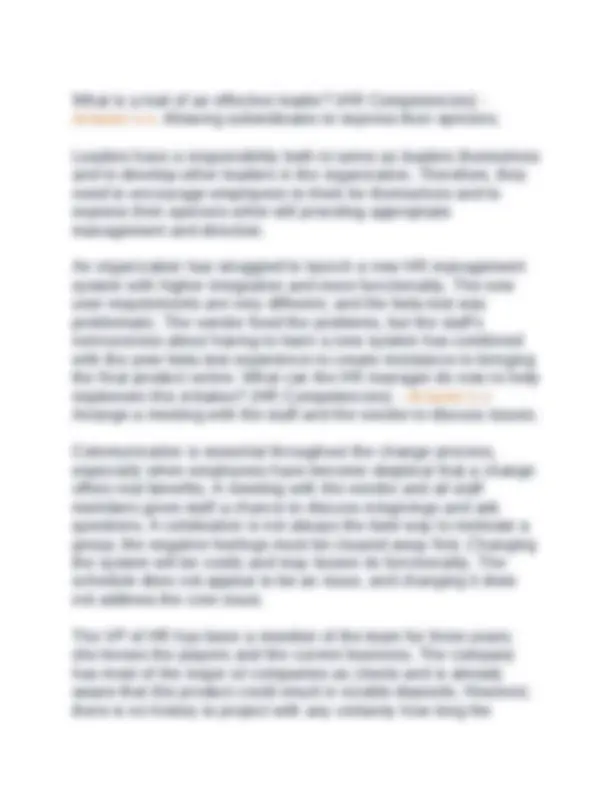
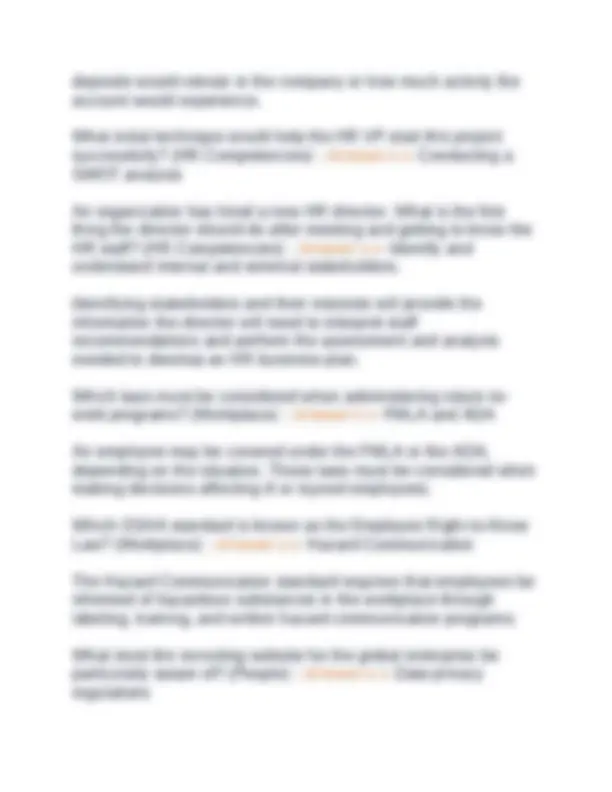
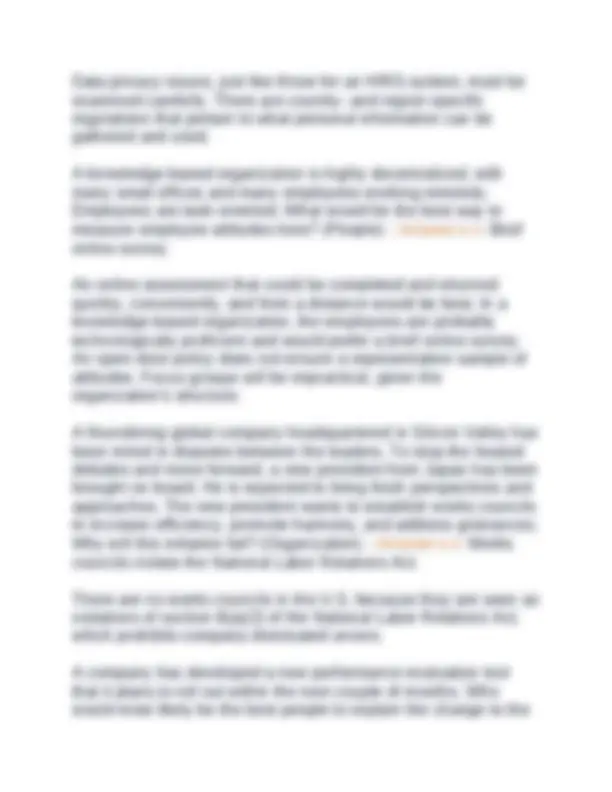
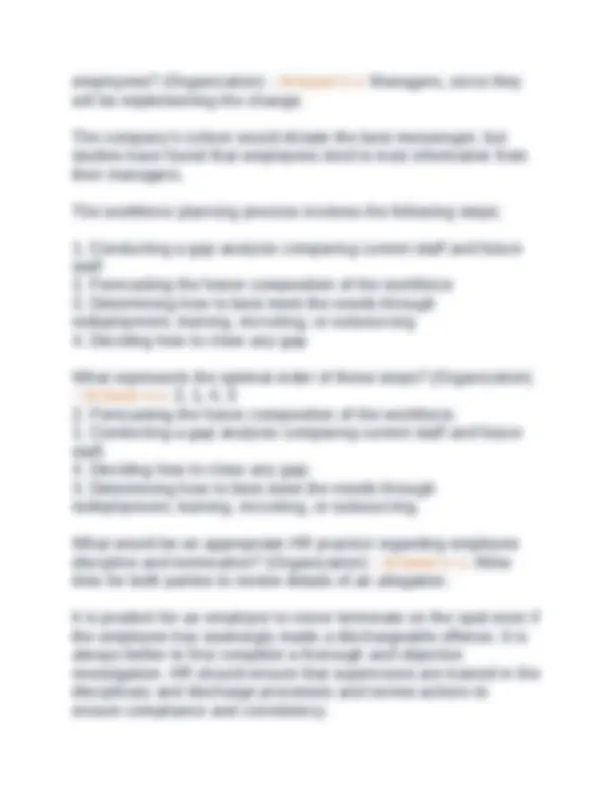
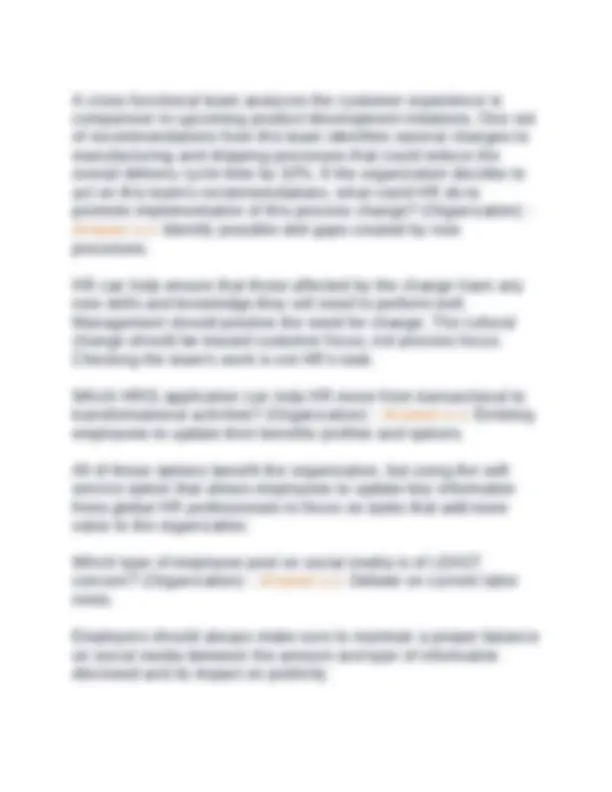
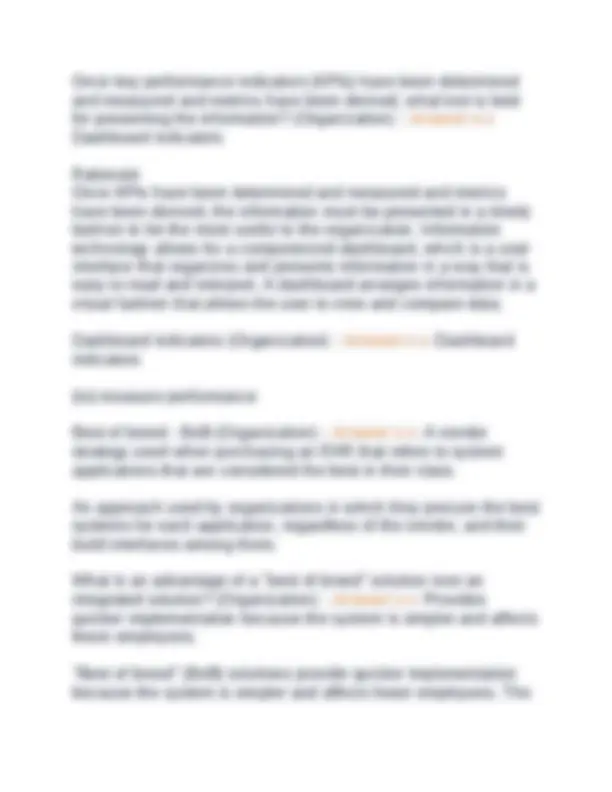
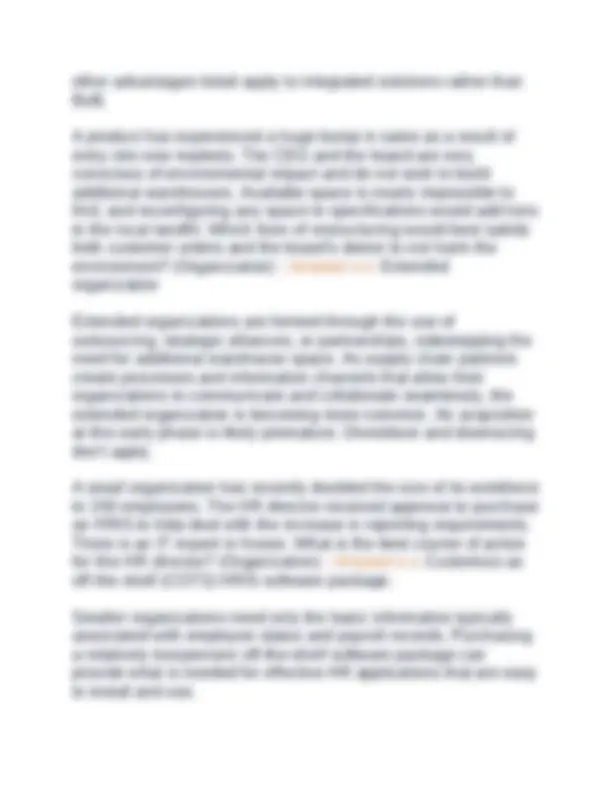
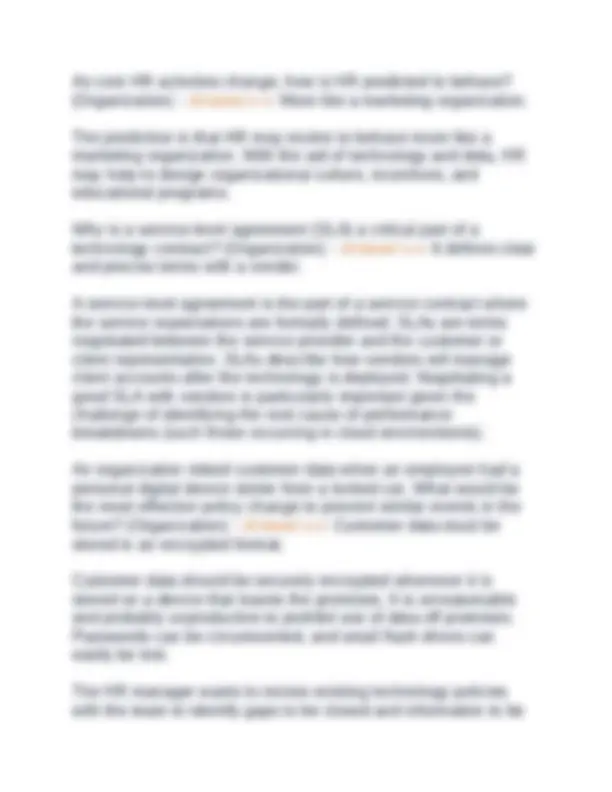
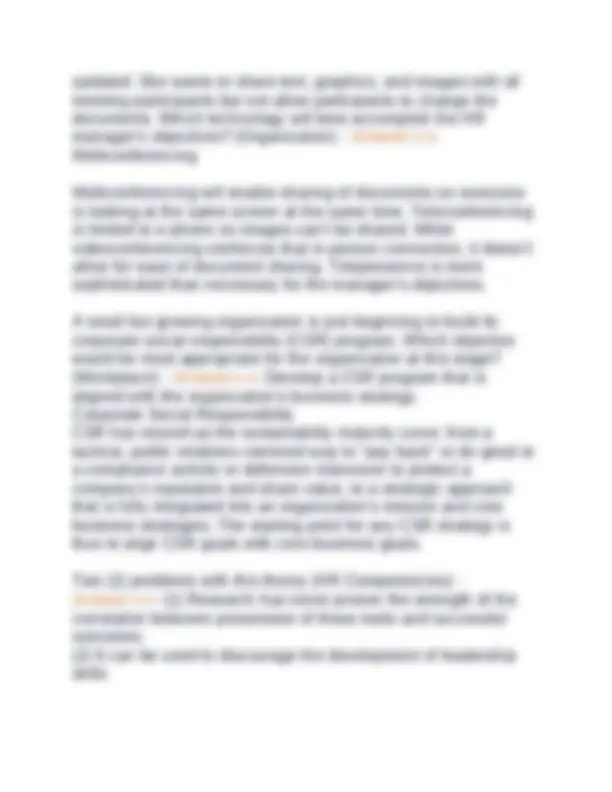
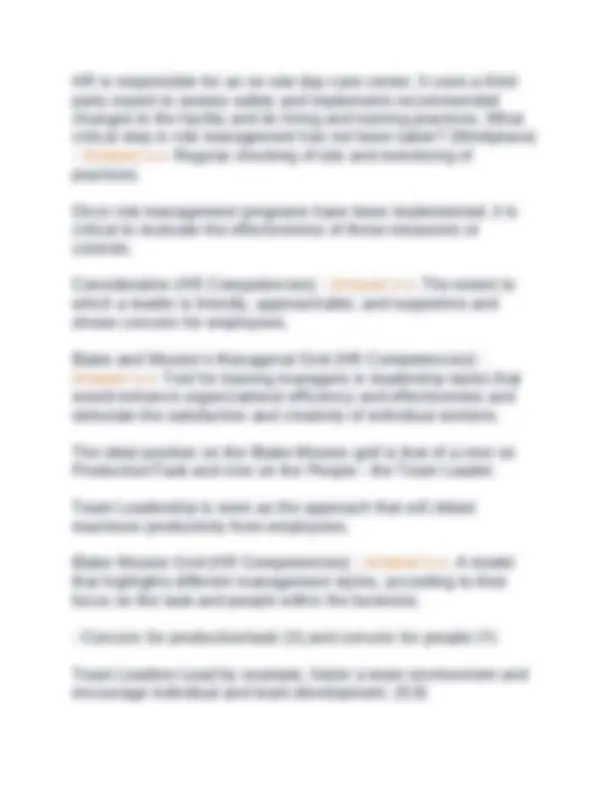
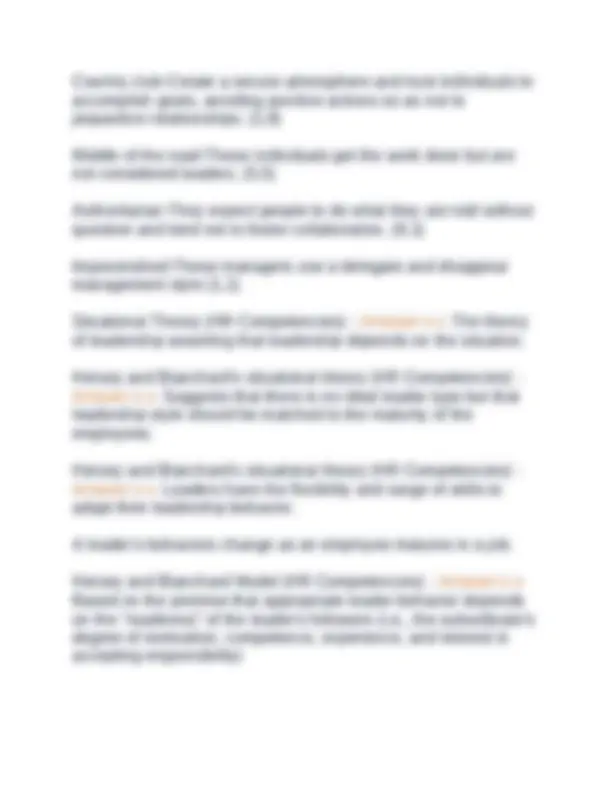
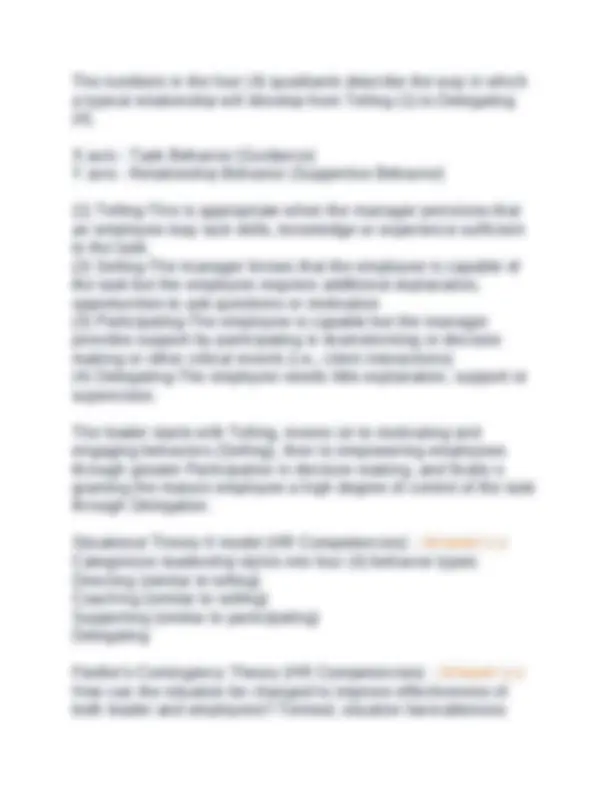
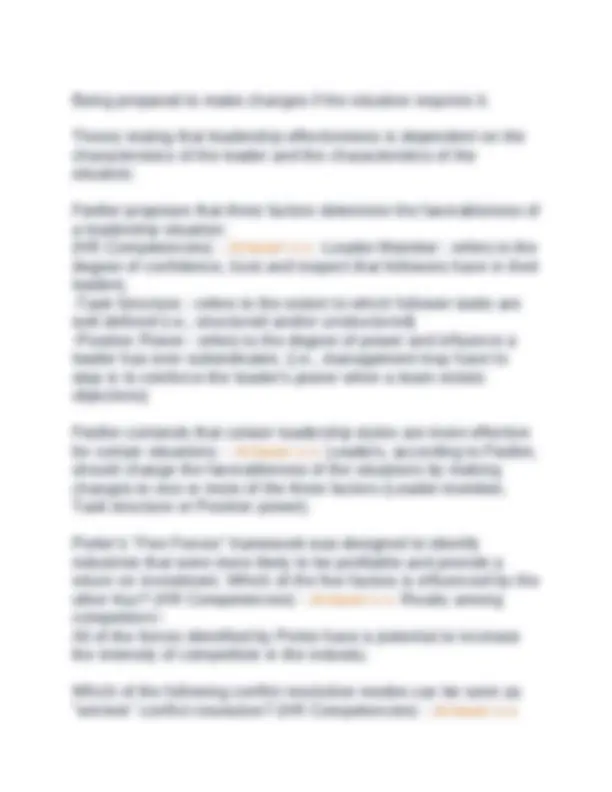
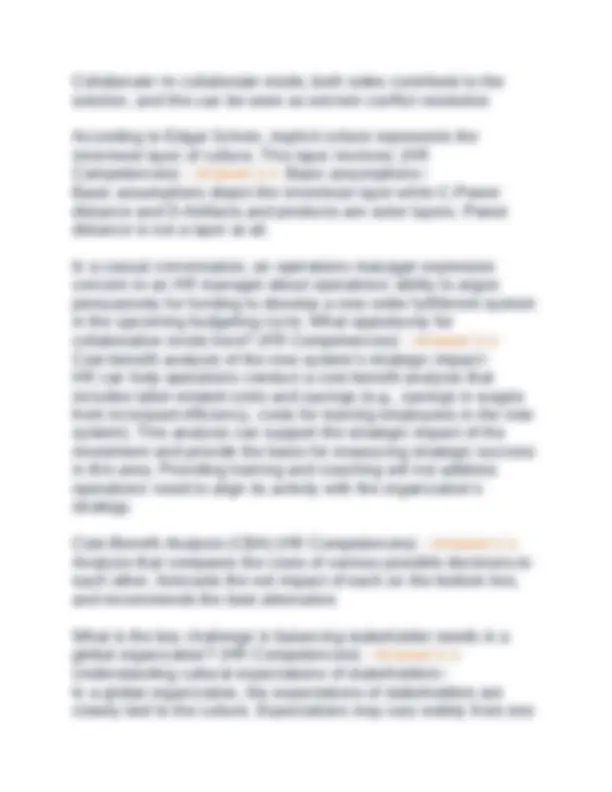
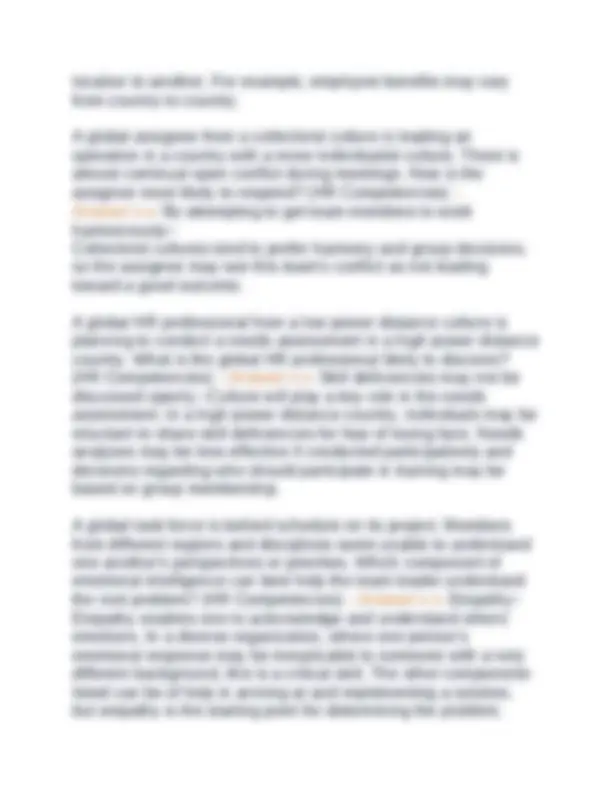
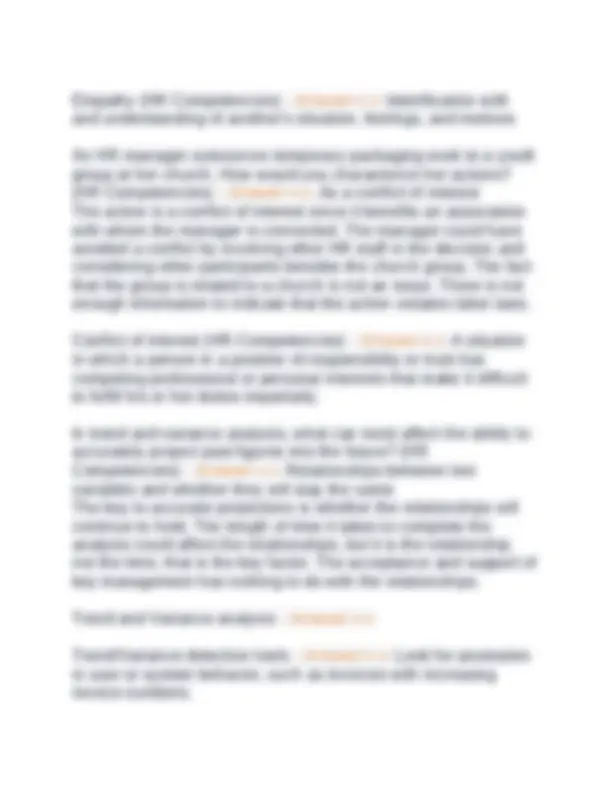
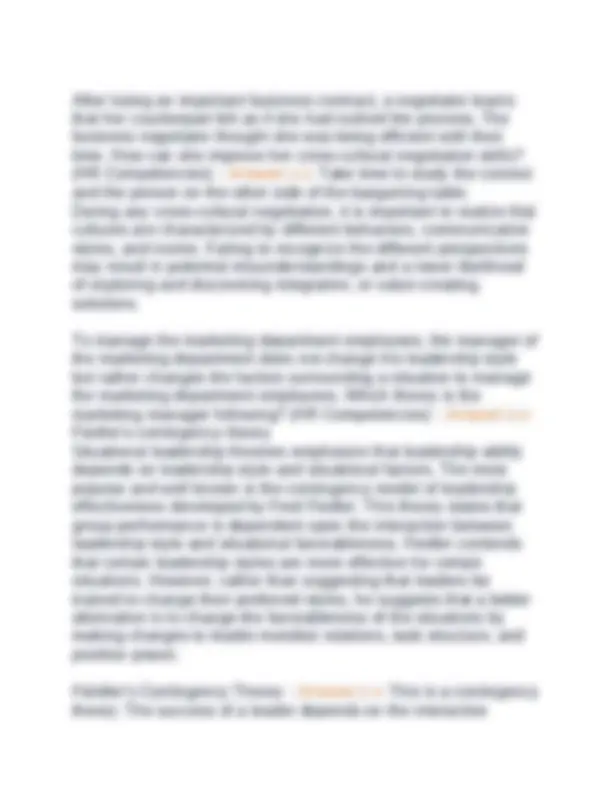
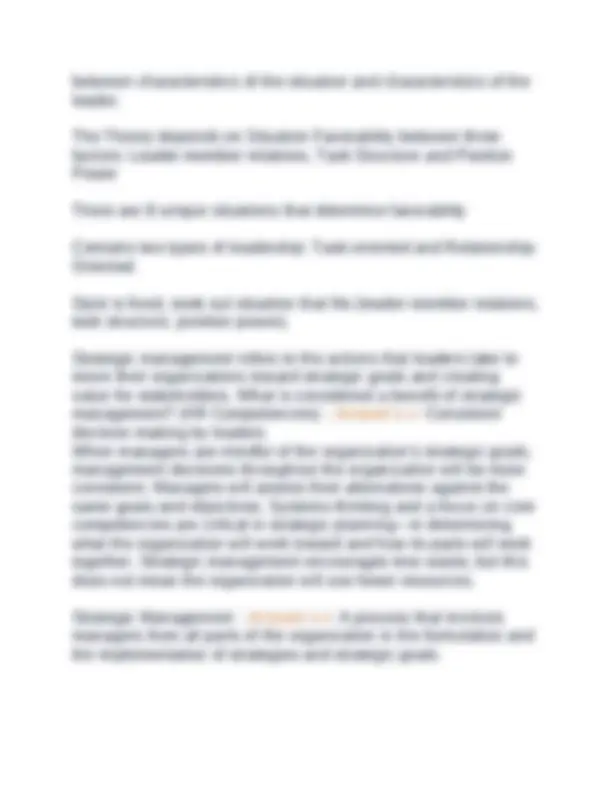
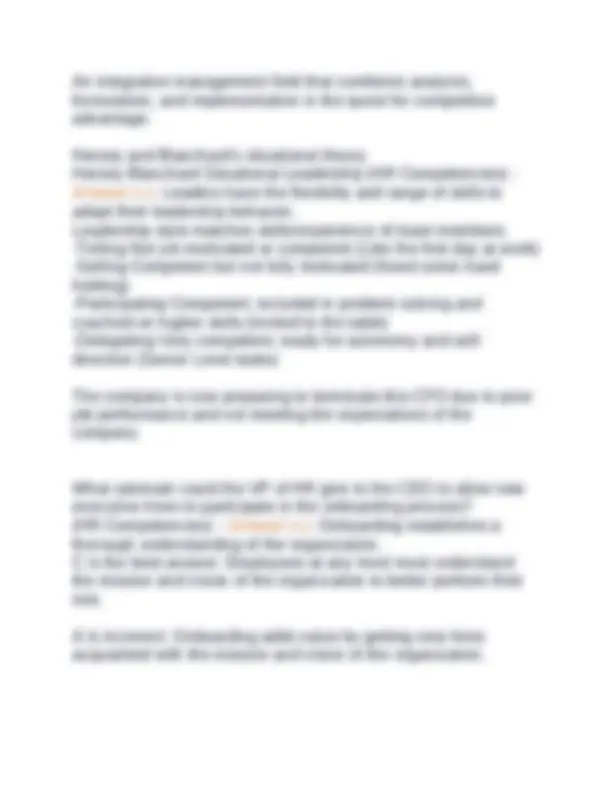
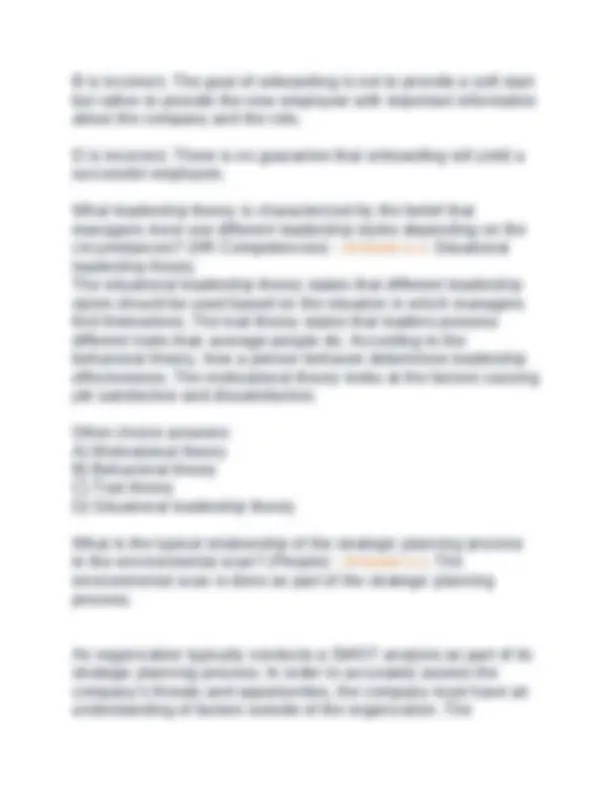

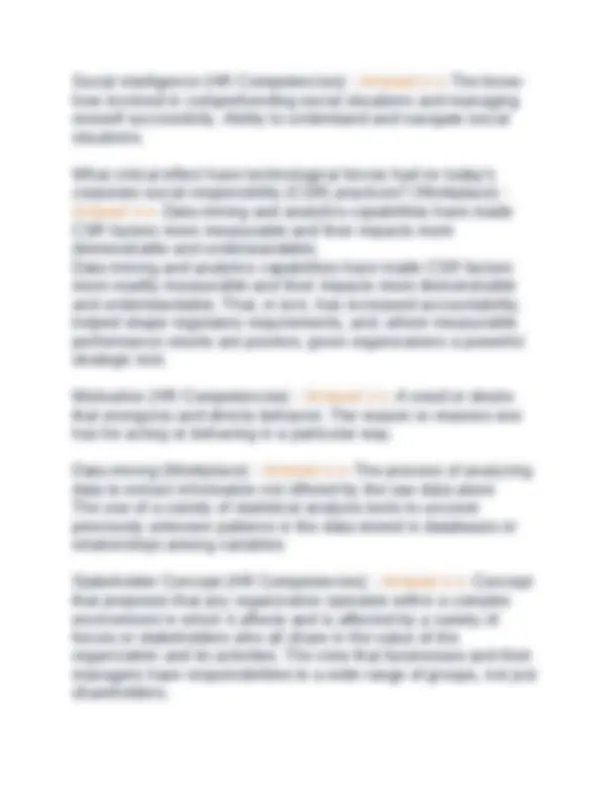
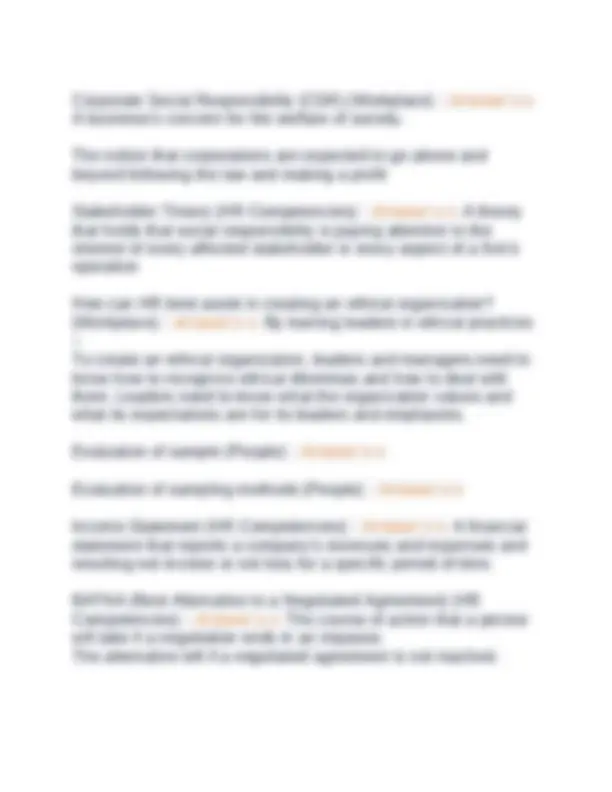


Study with the several resources on Docsity

Earn points by helping other students or get them with a premium plan


Prepare for your exams
Study with the several resources on Docsity

Earn points to download
Earn points by helping other students or get them with a premium plan
Community
Ask the community for help and clear up your study doubts
Discover the best universities in your country according to Docsity users
Free resources
Download our free guides on studying techniques, anxiety management strategies, and thesis advice from Docsity tutors
The role of global hr in developing and implementing global strategies for organizations. It highlights the need to balance standardization of policies influenced by the organization's values and global strategy with the need to localize these policies through programs and practices that reflect organizational and national cultures, as well as local laws. Various hr-related topics such as employee surveys, employee retention, leadership styles, and the democratization of hr data. It also touches on legal aspects like the hazard communication standard and the family and medical leave act (fmla). Insights into the challenges and best practices for global hr professionals in supporting strategic management and ensuring the organization's success in a global context.
Typology: Exams
1 / 317

This page cannot be seen from the preview
Don't miss anything!





























































































David Mungai [Date] [Course title]
Shareholder (Workplace) - Answer>> An owner of shares in a company. A person who invests in a corporation by buying stock and is a partial owner. Stakeholder (Workplace) - Answer>> Stakeholder is Everyone. Someone other than a stockholder or creditor who potentially has a claim on the cash flows of the firm. A person or organization with an interest in a particular place or issue. Strategy (Workplace) - Answer>> A long term plan. Are long term, are things that are long term goals. Strategies Do Not change that much. A plan of action or policy designed to achieve a major or overall aim. Plan of action for accomplishing an organization's overall and long-range goals. Strategy ~Larger, overall plan that can comprise several tactics. ~Broad, "big picture" ~Over time, long periods of time, future-oriented. ~A year of advertising and marketing plans for a company
i.e. Given a pay range with a minimum of $16.00 per hour and a maximum of $20.00 per hour, the midpoint is $18.00 per hour. The Compa Ratios for employees A, B, C, and D would be as follows: $16/$18 = .89 or 89% - Employee A earns $16. $16.50/$18 = .92 or 92% - Employee B earns $16. $18/$18 = 1.00 or 100% - Employee C earns $18. $19/$18 = 1.06 or 106% - Employee D earns $ Yield Ratio - Answer>> a ratio that expresses the percentage of applicants who successfully move from one stage of the recruitment and selection process to the next. Yield ratio in HR shows the percentage of candidates from the recruitment sources that were selected for the next stage of a hiring process. In simple words yield ratios show the efficiency of the certain recruitment method. Information about yield ratio allows HR. KPI-Key Performance Indicator Yield ratio = Number of leads from Recruitment Method/Number of candidates invited to interview x 100% Qualified Applicants/Total Applicants Female Applicants/Total Applicants Offers Extended/Final Interviews Minority Applicants/Total Applicants ROI - Answer>> Return on investment Gain from Investment - Cost of Investment/Cost of Investment ROI ex: Loaned $250.
You made 50% ROI Profitability ratio for a specific investment, such as a capital expense project. Its usually used to compare options. ROI - Answer>> Globalization (Workplace) - Answer>> Status of growing interconnectedness and interdependency among countries, people, markets and organizations worldwide. The process by which businesses or other organizations develop international influence or start operating on an international scale. Growth to a global or worldwide scale. Globalization (Workplace) - Answer>> Actions or processes that involve the entire world and result in making something worldwide in scope. The process by which businesses or other organizations develop international influence or start operating on an international scale. Others characterize the dimensions of globalization as a web of interconnectedness of the movement of people (labor) and knowledge (technology) across borders. Thomas L. Friedman calls it Globalization 3.0, when PESTLE, political, economic, social, technological, legal and environmental all converged. Global organization (Workplace) - Answer>> A global organization is one whose every process, action, and decision is firmly rooted in a carefully conceived global strategy.
Alliances, partnerships, and acquisitions are vehicles that can accelerate the path to globalization. Which growth strategy is commonly used to accelerate the path to globalization? - Answer>> Alliances Pull factors (Workplace) - Answer>> Factors that induce people to move to a new location/another location. Positive conditions and perceptions that effectively attract people to new locales from other areas. Which of the following is a "push factor" for global expansion? (Workplace) - Answer>> Need for new markets Organizations are pushed toward globalization in reaction to changes in the business environment (such as limited market opportunities in their home countries). The other factors listed here are "pull factors." Organizations are pulled toward globalization through the promise of achieving greater organizational value. Which of the following is considered a "pull factor" in attracting organizations toward globalization? (Workplace) - Answer>> Greater strategic control A "pull" globalization factor is an attribute of globalization that an organization wants to achieve--in this case, greater control over strategic goals. The other factors are "push" factors, ones that oblige an organization to go global to remain competitive. An employee has been selected for an international assignment. This first-time assignment is expected to last two to three years and involves full relocation. Why is a well-crafted global letter of assignment a key part of the assignment plan? (Workplace) -
Answer>> It addresses the terms and conditions of the assignment. A letter of assignment evolves from the assignment plan and addresses the business aspects of the assignment as well as compensation, benefits, and local work rules. Taking the time to ensure that the information provided is clearly articulated, thorough, consistent, and unambiguous sets clear and reasonable expectations between the employer and the employee. In turn, this information sets the stage for a successful first-time international assignment. A letter of assignment does not address culture shock or repatriation specifics (although it may include information about termination policies). Third-party vendors may still be needed through various phases of deployment, repatriation, or redeployment. What critical role does HR need to assume in light of today's globalization forces? (Workplace) - Answer>> Balancing policy standardization to reflect an organization's global strategy with policy localization to reflect national cultures and laws Globalization has made the role of HR more critical and more complex. In developing and implementing global strategies, global HR must constantly balance standardization of policies influenced by the organization's values and global strategy with the need to localize these policies through programs and practices that reflect organizational and national cultures and local laws. What impact an organization's Local Responsiveness (LR) globalization strategy have on the HR staffing strategy? - Answer>> More emphasis on mentoring and talent management.
process, not an activity. All criteria, not just functional and communication skills, should be considered in candidate selection. A Taiwanese manufacturer of electronic components for major global brands has sites in several emerging economies, including Vietnam, Turkey, and Mexico, and in the U.S. What offshoring trend does this exemplify? - Answer>> Multidirectional shift in the flow of offshoring jobs to and from developed and emerging economies. The motivations for offshoring, and, consequently, where it is taking place and which firms are adopting it as a global strategy, are changing as a result of new globalization forces, principally the shift from developed to emerging economies. The flow of offshoring jobs is now going in both directions or, rather, in many directions at once. KNOW THESE TERMS: - Answer>> What critical role does HR need to assume in light of today's globalization forces? (Workplace) - Answer>> Balancing policy standardization to reflect an organization's global strategy with policy localization to reflect national cultures and laws. Globalization has made the role of HR more critical and more complex. In developing and implementing global strategies, global HR must constantly balance standardization of policies influenced by the organization's values and global strategy with the need to localize these policies through programs and practices that reflect organizational and national cultures and local laws. Which company illustrates a geocentric global orientation as described by Perlmutter? (Workplace) - Answer>> Senior
management personnel from all countries are considered to be part of a single global resource pool. In a geocentric global orientation, the organization is viewed as a single international business with a global orientation. Global assignments based on business strategy - Answer>> Domestic:
-Marital Status INTERNAL DIMENSIONS (Second layer) -Age -Gender -Sexual orientation -Physical ability -Ethnicity -Race PERSONALITY (Middle/Center) What is the underlying rationale for devising the four-layer model of diversity? (Workplace) - Answer>> It provides a framework for understanding the range and complexity of diversity issues. Gardenswartz and Rowe's model attempts to provide a thorough, inclusive definition of diversity. It offers a useful framework for understanding the range and complexity of the issue of diversity. Perhaps the greatest benefit of this model is that it underscores the fact that we are all multidimensional. In the four-layer model of diversity, which layer consists of the results of life experiences and choices? (Workplace) - Answer>> External dimensions Are the effects of diversity on an organization's branding efforts most likely to be positive or negative? (Workplace) - Answer>> Either positive or negative. The positive image of being a diverse, global, inclusive organization can in and of itself be a marketing advantage and selling point, helping the organization to connect and identify a brand with diverse markets. However, targeted marketing efforts that attempt to focus on specific diversity identity groups can, over time and by cumulative effect, start to blur the core brand image.
ADDIE model (People) - Answer>> Analysis Design Development Implementation Evaluation Five-step instructional design process that governs the development of learning programs. Analysis/Assessment - First phase of ADDIE is analysis or assessment, data is collected to identify gaps between actual and desired organizational performance. A needs analysis assesses and identifies developmental needs at three levels: organizational, task and individual. Design- Second phase of ADDIE is design. During this important phase broad goals and objectives are developed and broad plans for the treatment of the content and the strategy for implementation are made. The outcome of the design phase is an architecture or rough sketch of what the final program will look like. Development - Third phase is the development phase, during this phase materials are created, purchased or modified to meet the stated objectives. Existing or old materials both need either minor modifications or to be developed. Case studies; Round robin; Role plays; Structured exercises; Simulations; Fishbowl activities; T-groups. Implementation - Is the phase of ADDIE where the program is delivered to the target audience. Pilot programs, revisions to content, announcements and launch events, participant scheduling, and preparation of the learning environment, are done during implementation.
Because this is a targeted effort to attract at-risk students, students who are not at risk will not qualify and their parents may feel their children should not be excluded from the benefits of this initiative. Since at-risk students are the target audience, similarity bias doesn't apply; neither does bias-based exclusion. Although students (rather than parents) might engage in "covering" behavior, it is not the dynamic most likely to work against this initiative. HR has been assigned the task of designing and implementing the training and development component of an organization's diversity and inclusion strategic initiative. What should be the primary goal of the courses HR designs for management? (Workplace) - Answer>> Helping them manage diverse teams effectively and foster an inclusive work environment. The key goal of management-directed training is helping executives learn to manage more effectively. Diversity awareness courses aimed at the entire organization (another key training component) will focus on their ability to better understand minorities and their own attitudes toward them (and to not believe they have "limitations to overcome"). What functions within an organization are most likely to experience increased costs due to increased diversity? (Workplace) - Answer>> Training and recruitment. Diversity can increase costs for training in cultural awareness, communication, and team building, and it can increase costs and time frames for recruitment efforts, since a broader diversity- based talent search often requires new resources, procedures, and validation measures. HR has four tools at its disposal in influencing managerial practices and developing new managerial skills, often referred to as the 4 Ts. Travel, training, and transfers are three of them.
What is the fourth T, and what is its purpose? (Workplace) - Answer>> Teams. Working on global teams and international projects helps executives develop cross-cultural management skills. The 4 Ts are travel, teams, training, and transfers. They can be valuable strategies for creating a global mindset and enhancing the multicultural awareness of leaders and senior managers. In regard to teams, managers can be trained to form all their teams with an eye toward diversity and inclusion (gender, generational, cultural, etc.), not just for its own sake but for the problem-solving and innovation advantages of more-diverse teams. 4Ts (Workplace) - Answer>> Travel, teams, training and transfers. Strategies for creating a global mindset and enhancing multicultural awareness of leaders and senior management. An organization launched its first diversity and inclusion initiative roughly five years ago. In recent months, there has been an increase in younger people leaving the organization. In exit interviews, these employees complain about being ignored by management. Which kind of data should HR collect to help measure inclusion? (Workplace) - Answer>> Data reflecting how these employees were treated and how they feel they were treated. To help measure inclusion, HR should collect data reflecting how the departing employees were treated and how they feel they were treated by management. This requires both objective and subjective data. The employees' participation on work-related committees doesn't necessarily reflect a feeling of inclusion, especially if they feel their views are ignored. Customer feedback about branding isn't relevant to employee inclusion. Demographic representation just addresses numbers of people in a category, not how included those people feel.
Design Development Implementation Evaluation Training gaps are best identified during the assessment phase of training. The design and development of the training program and evaluation tools are based on the performance gap analysis. An HR task force has determined that storms that could interfere with the ability of critical personnel to reach work occur with moderate frequency in a particular area. Forecasting has become very good (but not perfect) at providing accurate advanced warning. The group is using a PAPA model to decide appropriate risk management strategies. What approach are they likely to take for this risk? (Workplace) - Answer>> Prepare. It is best to prepare for events that unfold quickly (even with warning) and are moderately probable. A highly probable and fast-moving event might cause the organization to maintain capabilities that can be initiated immediately (e.g., redundant offices in other locations). This would be an Act strategy. Adapt strategies are for slow-moving events, such as foreseeable demographic changes. Park strategies are for rare events that unfold slowly. PAPA-Prepare Act Park Adapt (Workplace) - Answer>> Evaluating Risks - Risk prioritization matrix, PAPA model Vertical axis the speed of change-Slow to Fast. Horizontal axis access the degree of likelihood-Low to High. P A P A
Prepare events are not likely to happen but will materialize quickly if they do occur. That means contingency plans must be in place and early indicators defined. Act events are both highly probable and fast moving. These threats and opportunities require immediate responses in terms of enhancing the chances for opportunities and decreasing the chances of a threat occurring or creating significant damage. Park events are slow-moving and unlikely. They merit monitoring for changes in their characteristics but not investment in mitigation or contingencies. Adapt events are actually slowly materializing trends that may affect the organization significantly. Unions and Strikes - Answer>> Union is an association of workers, formed to bargain for better working conditions and higher wages. Union Strikes - Answer>> When people will refuse to work in order to receive certain benefits, such as more pay, longer hours, and other benefits. When a strike occurs HR must implement contingency plans, deliver training and arrange payment to replacement workers. Examples of Industrial Actions: (Organization) - Answer>> General strike - Work stoppage. Sit-down strike - Refusal by workers to work Sympathy strike - Action taken in support of another union that is striking the employer.